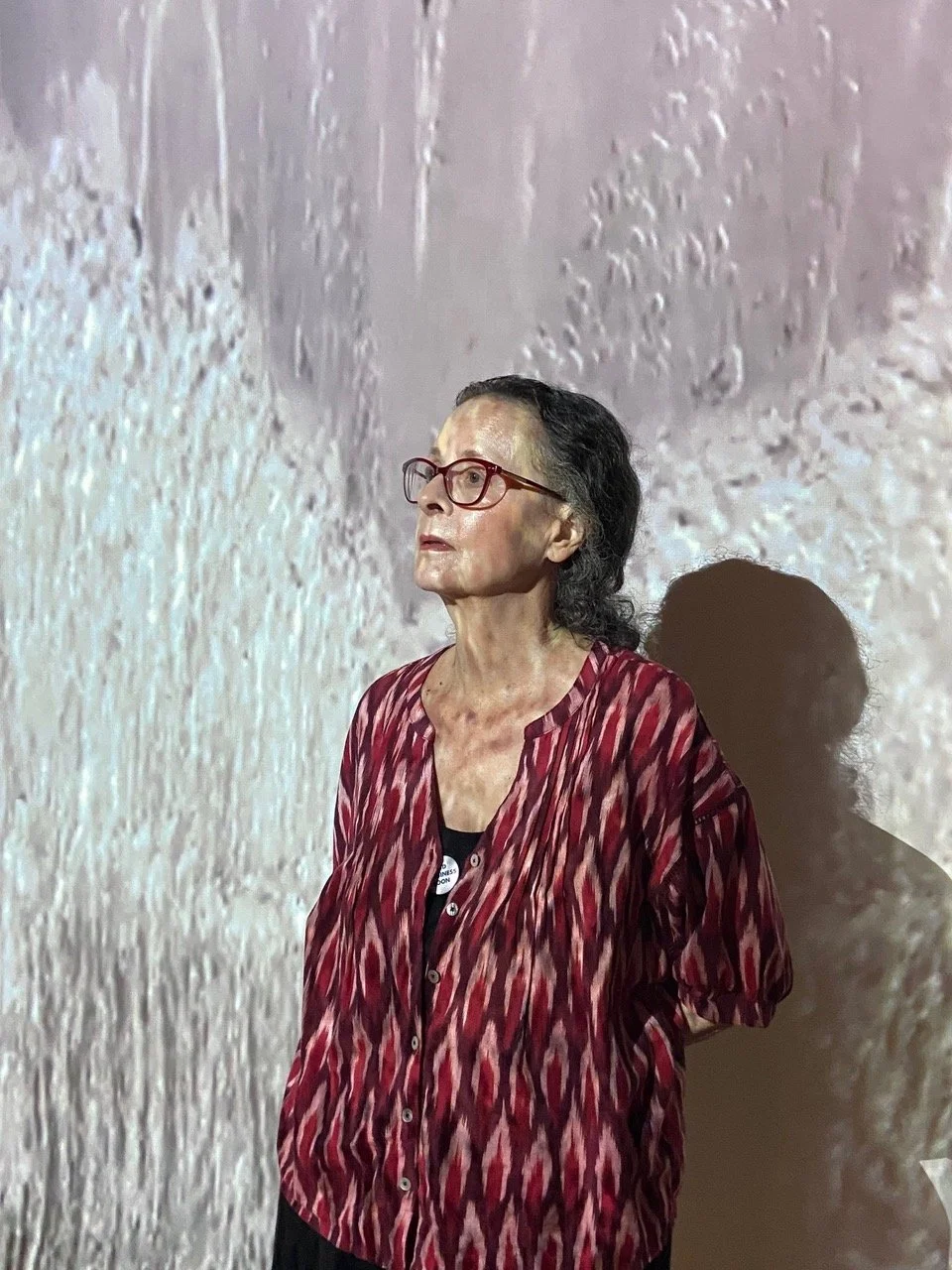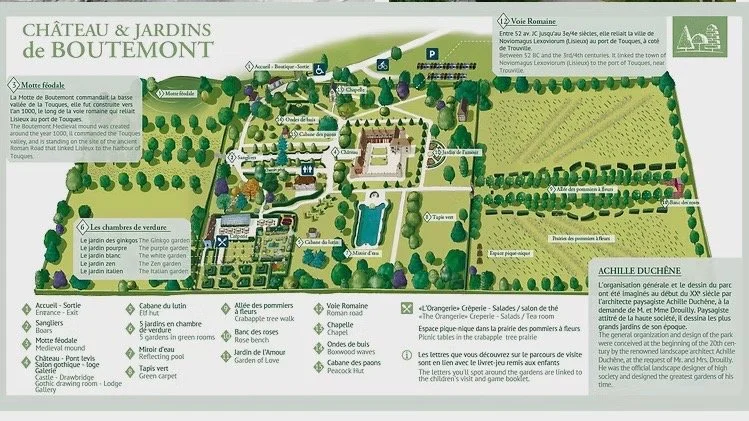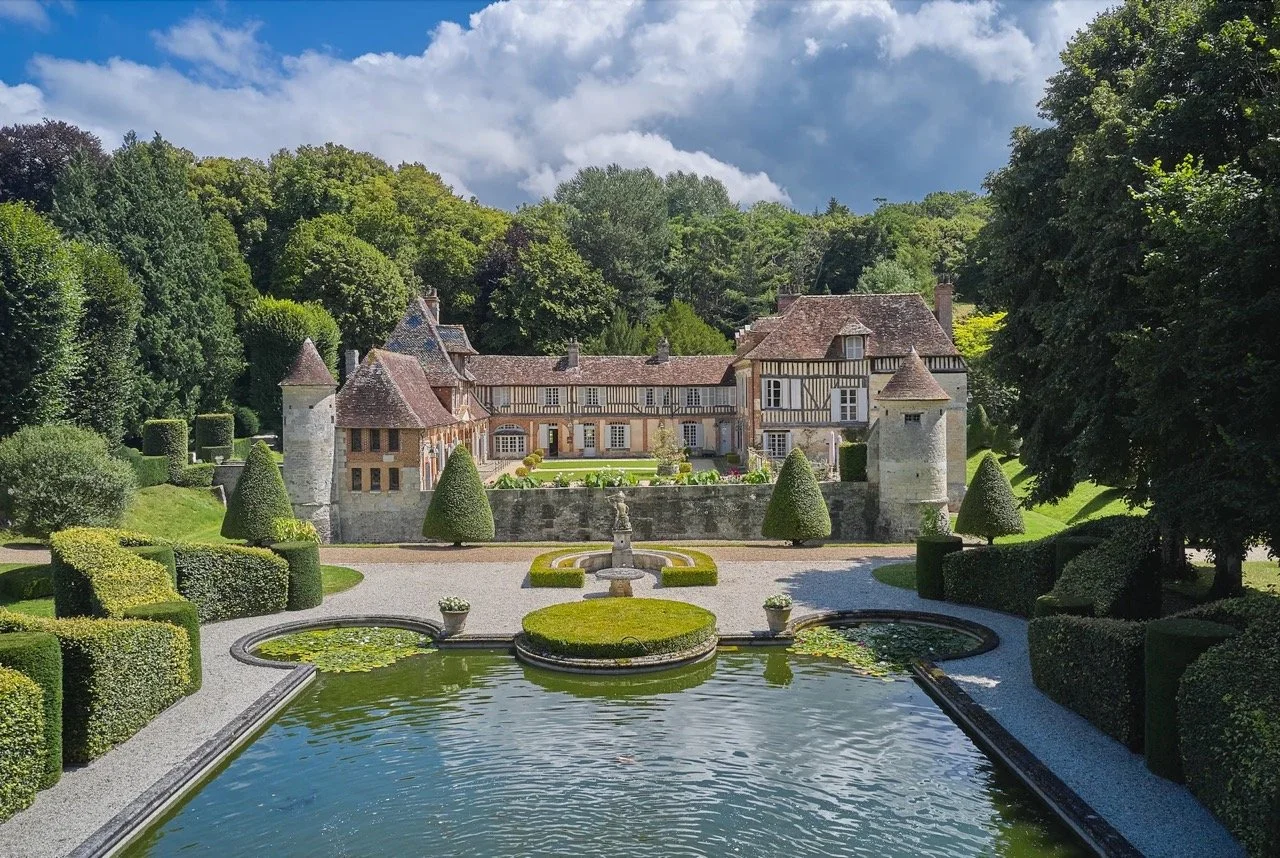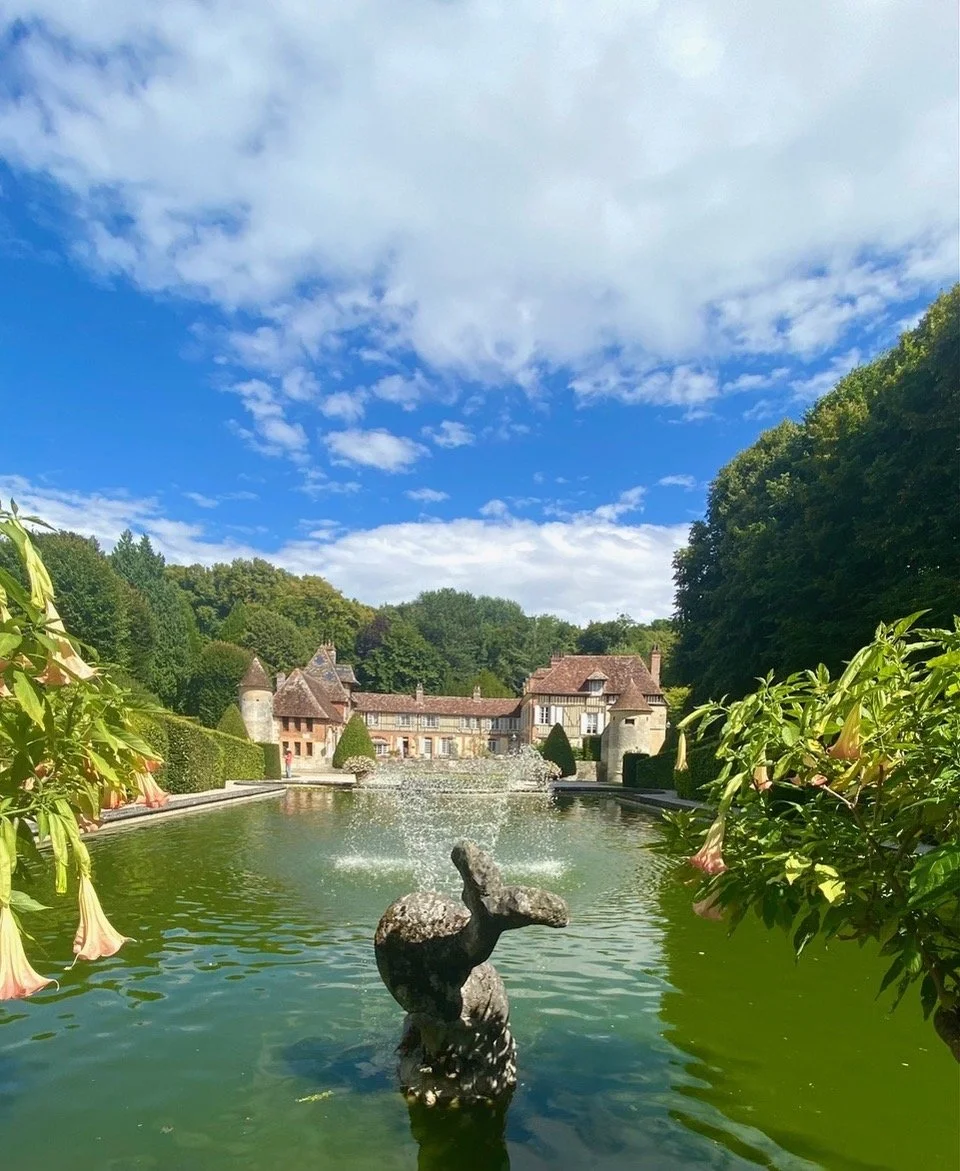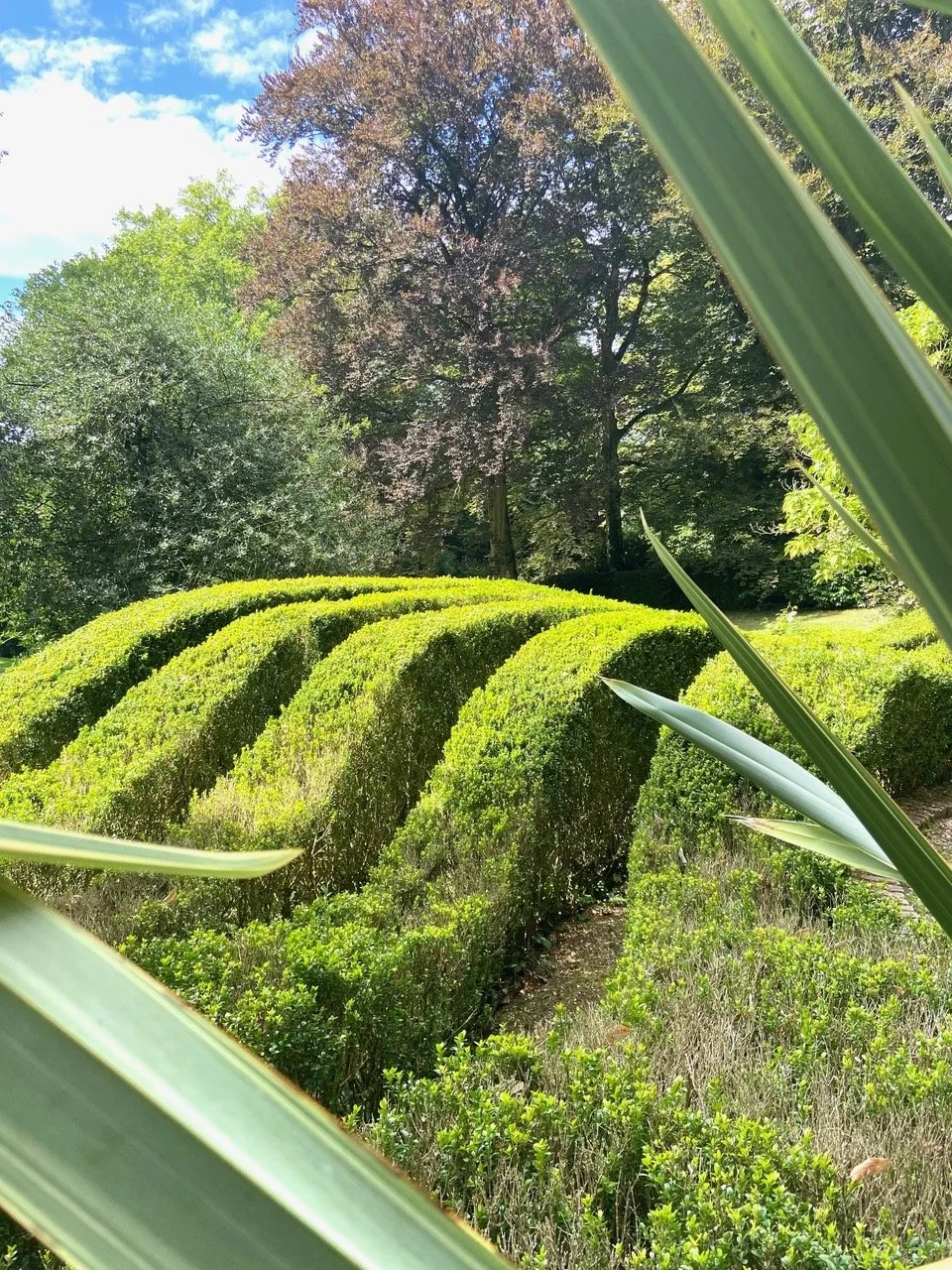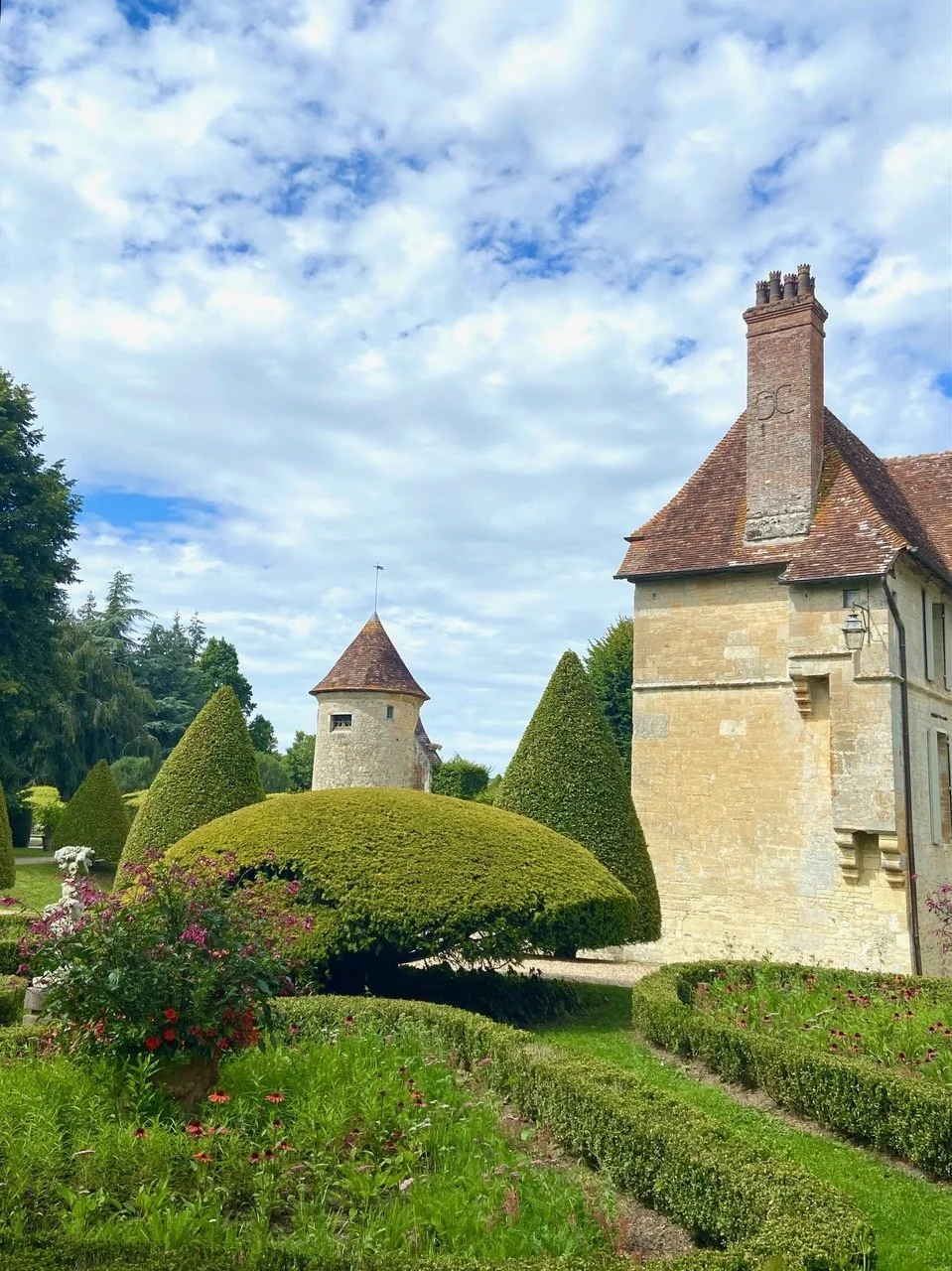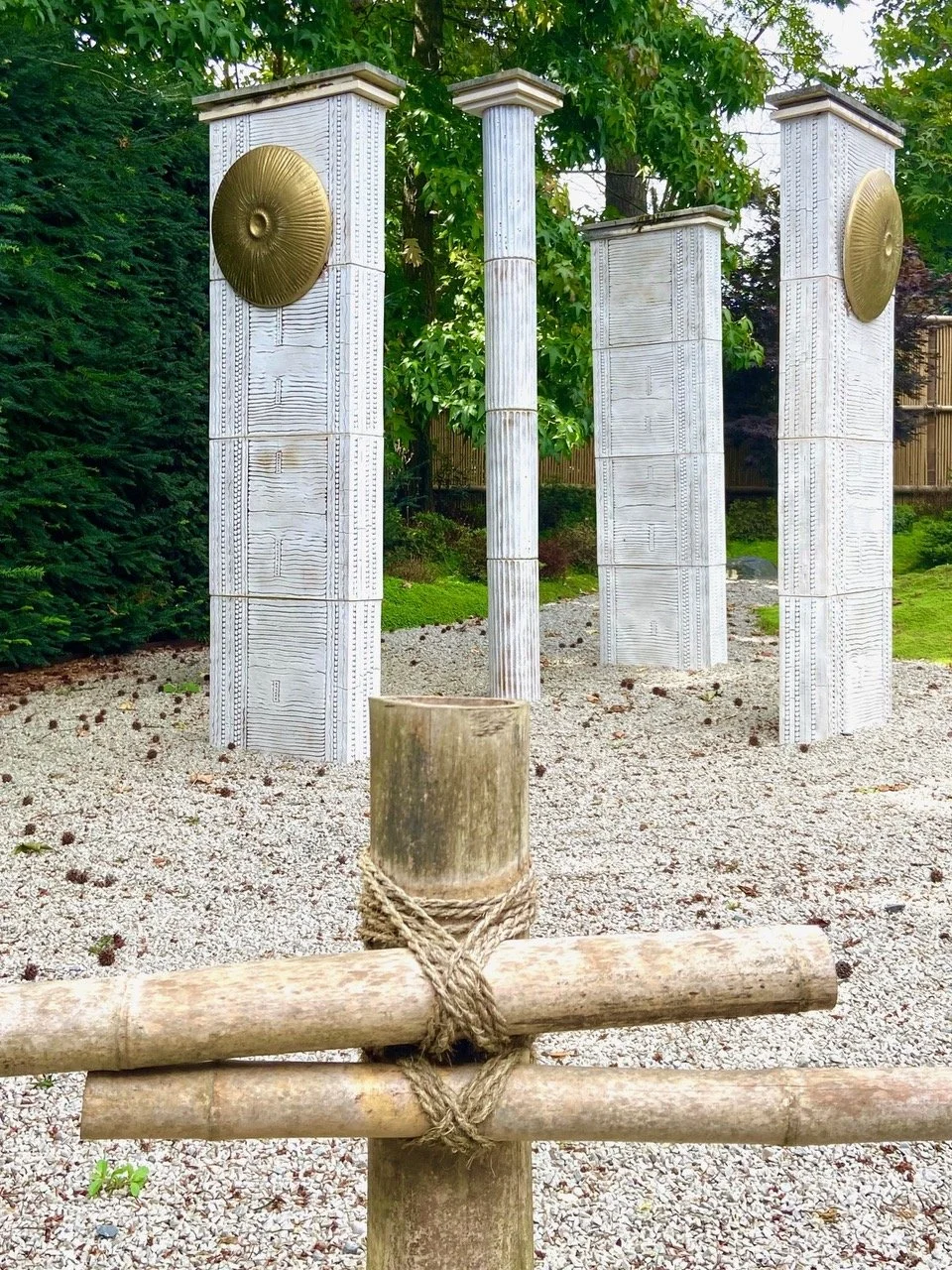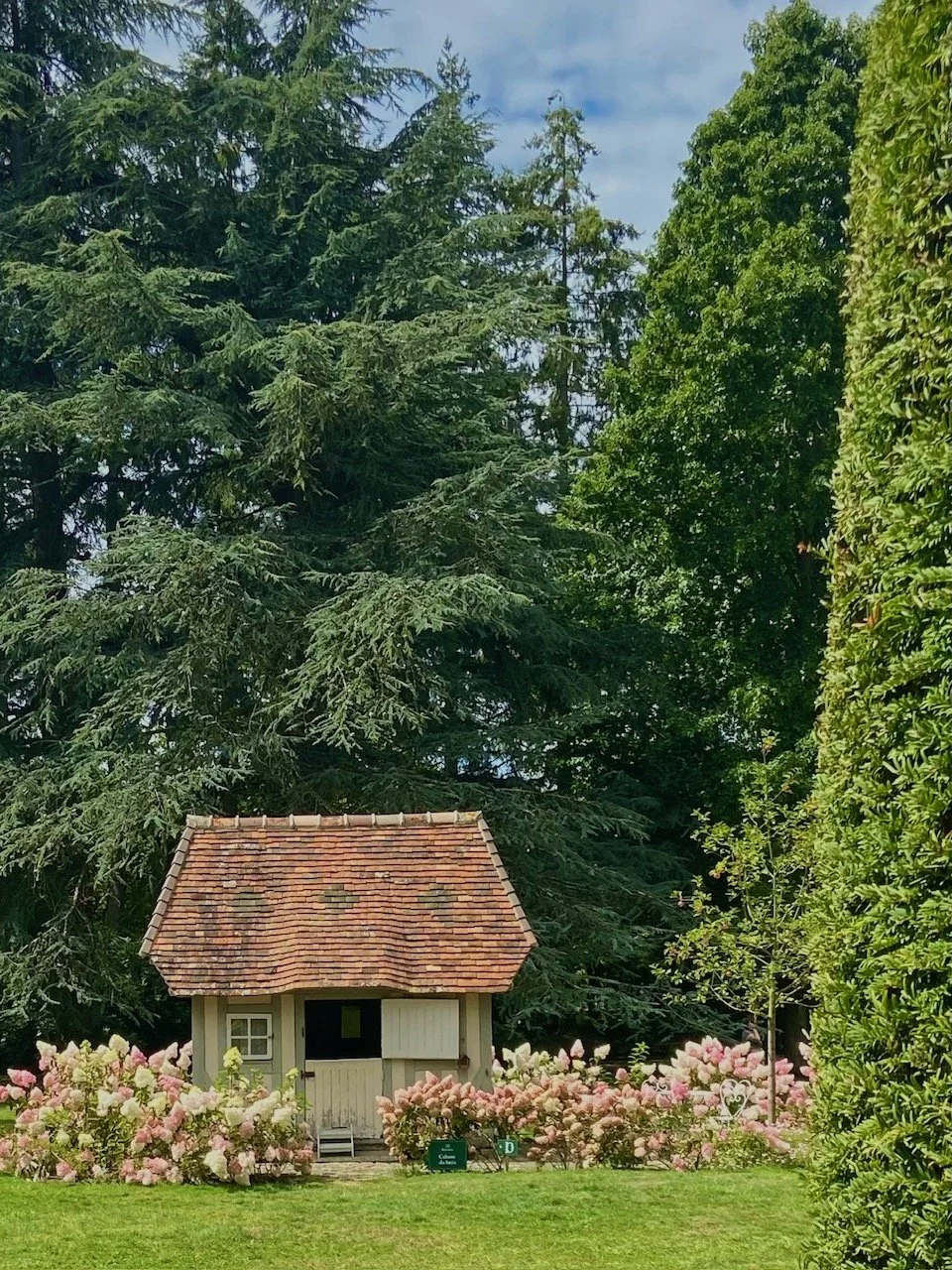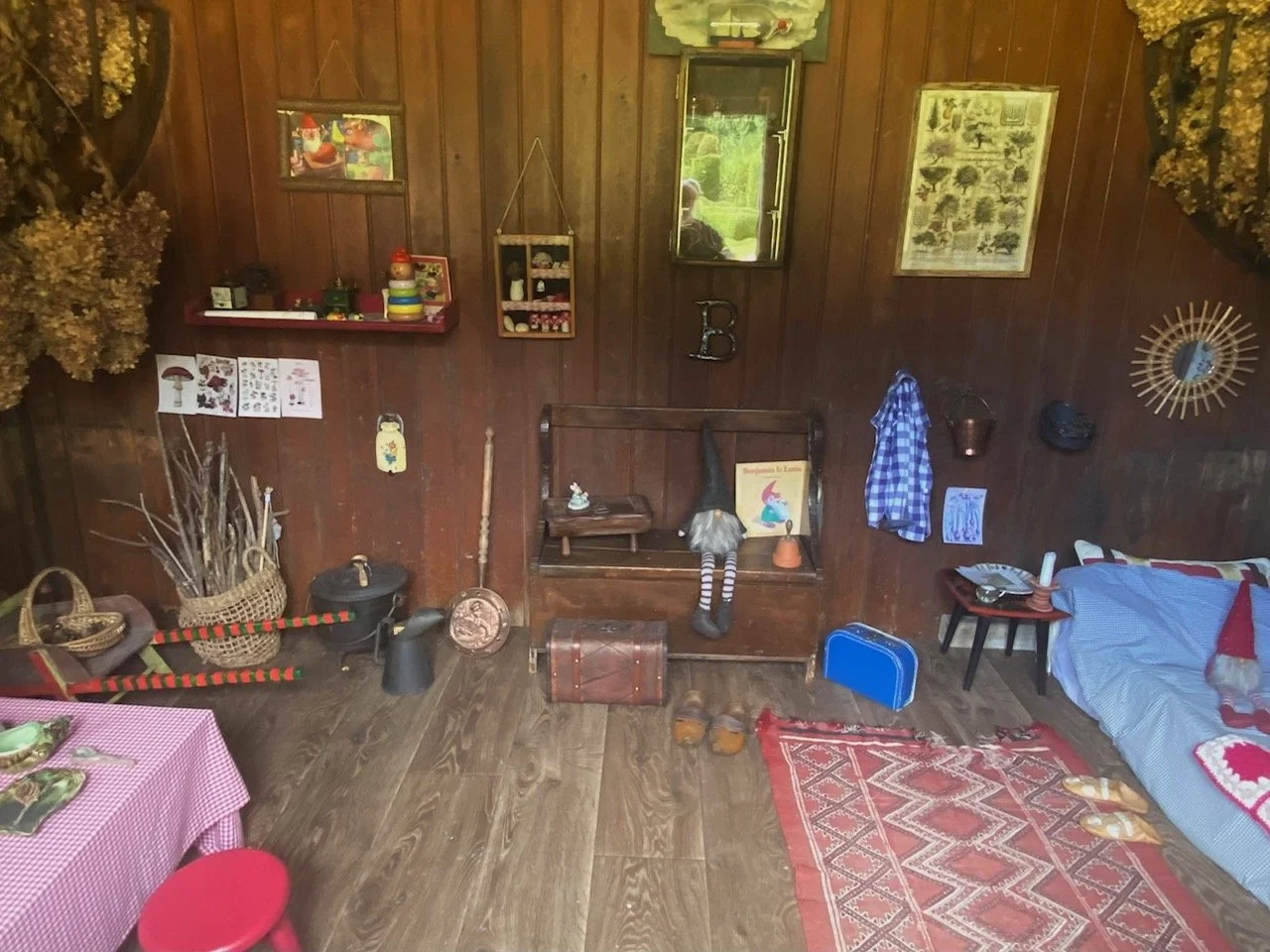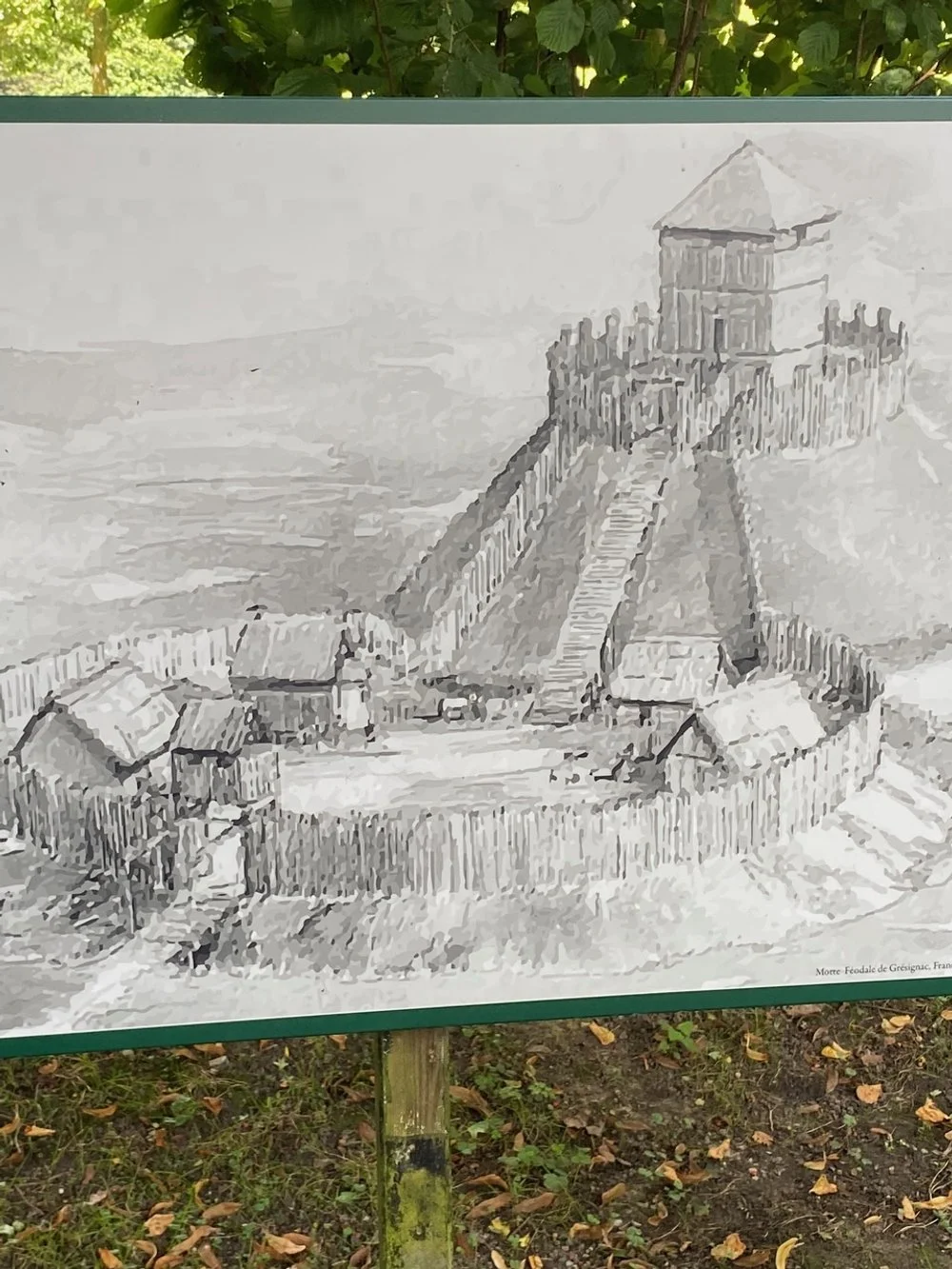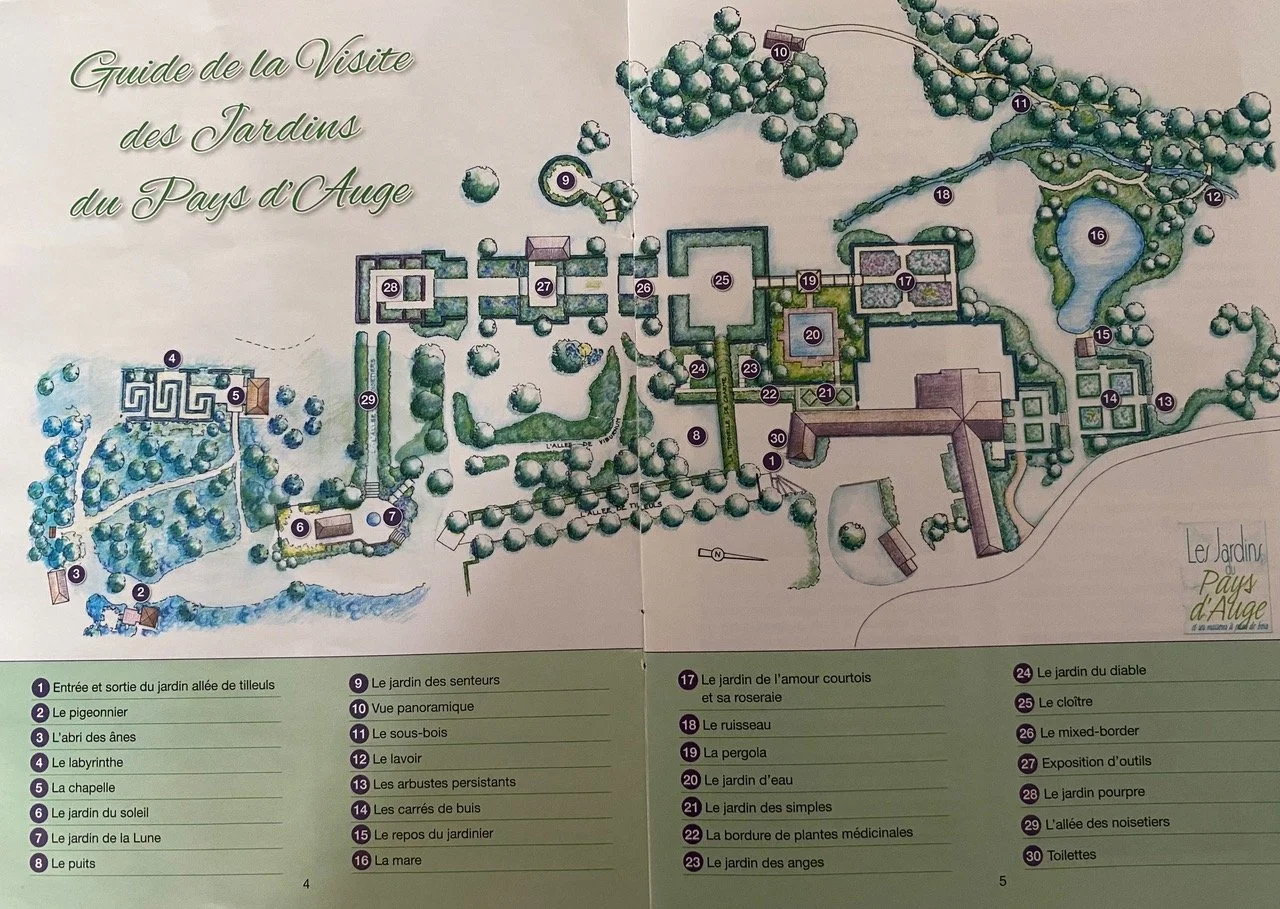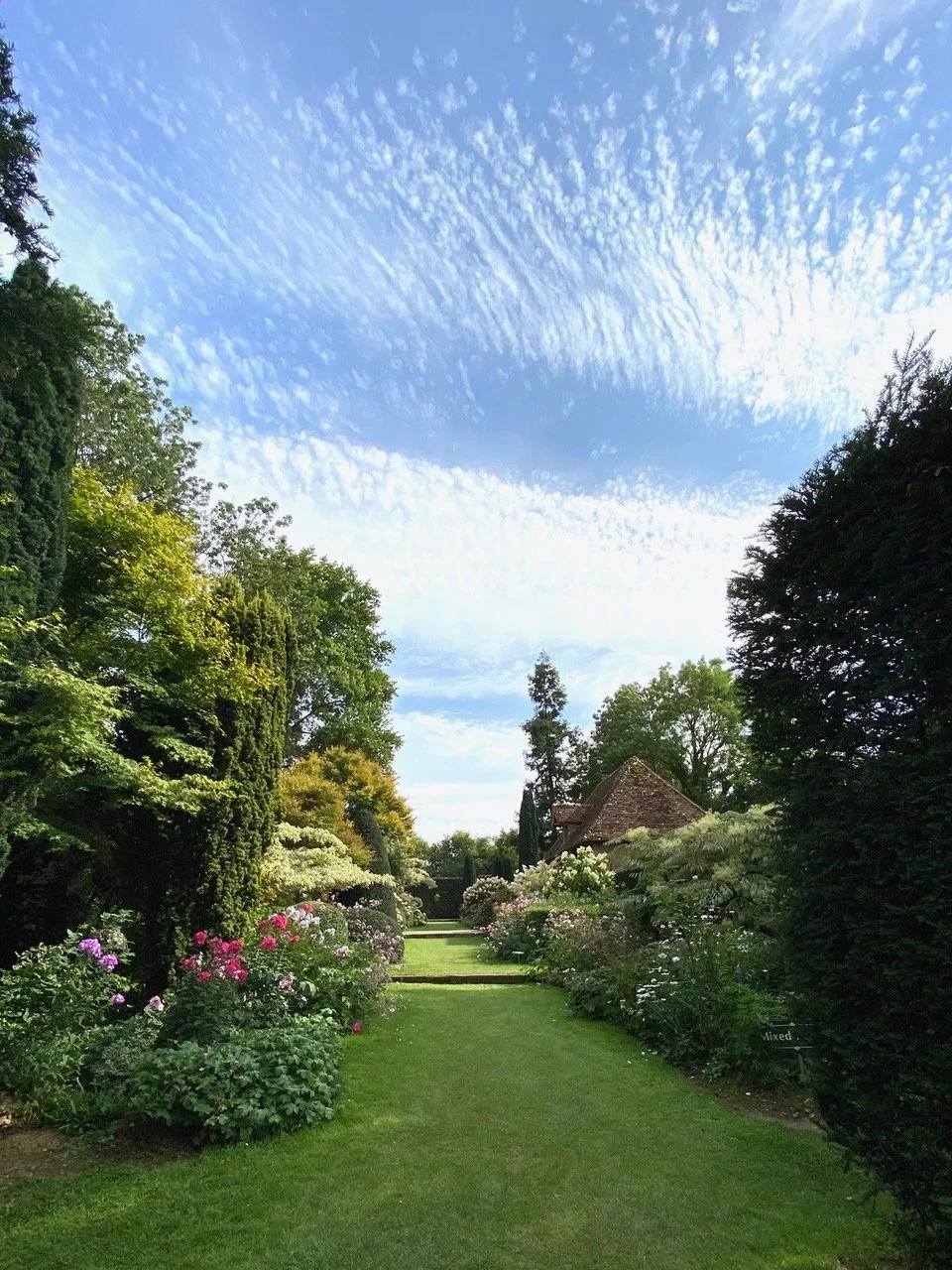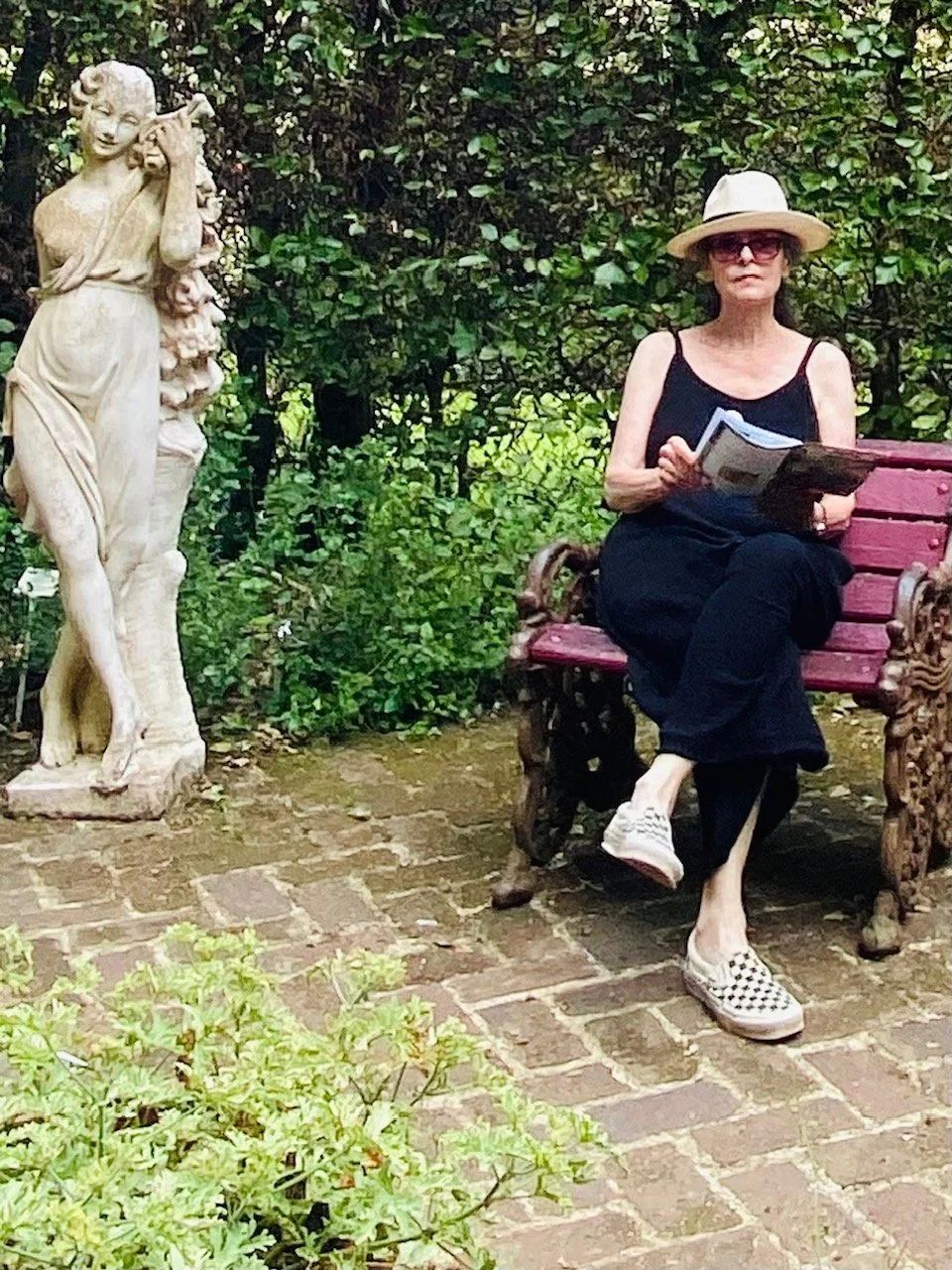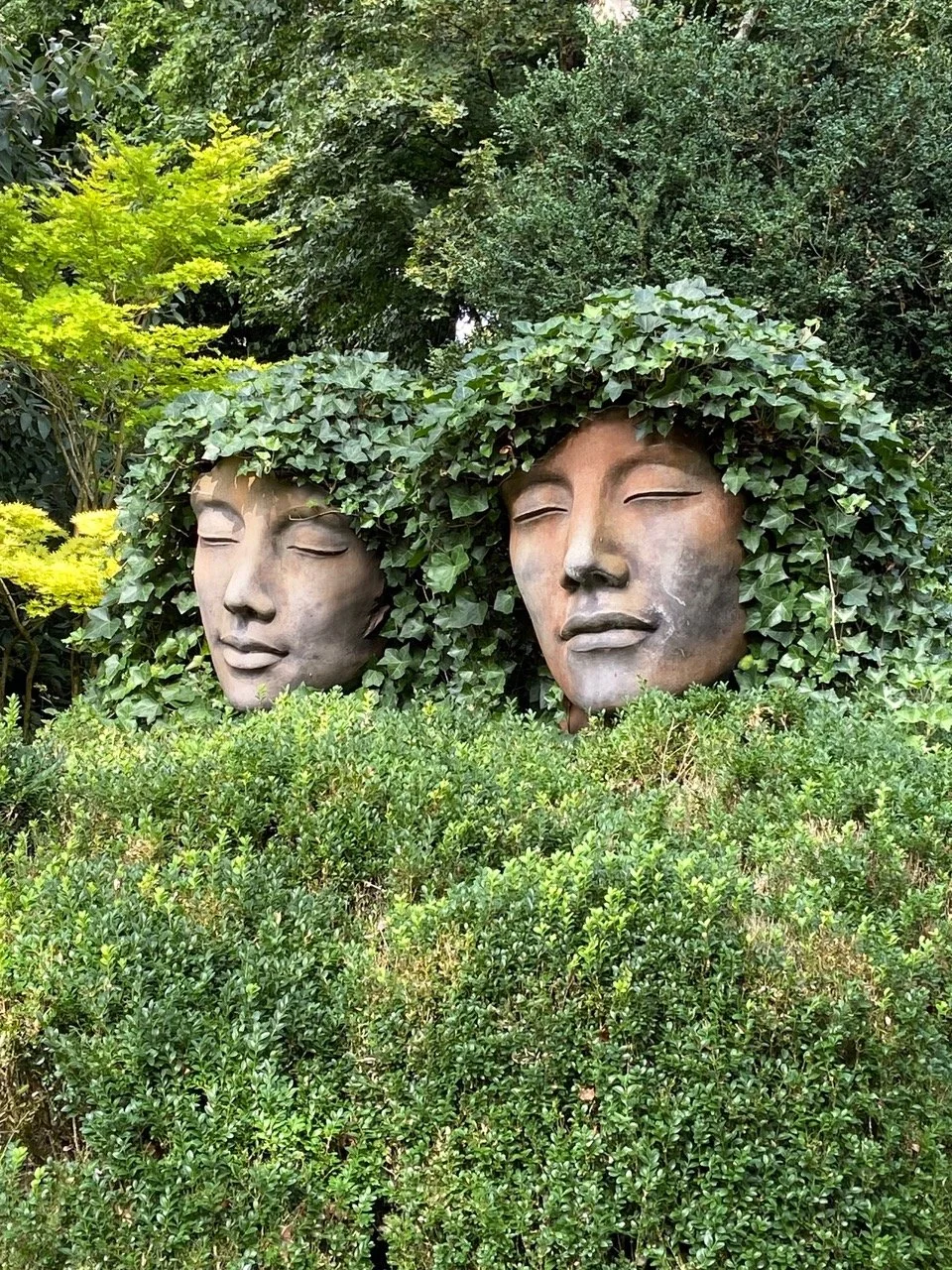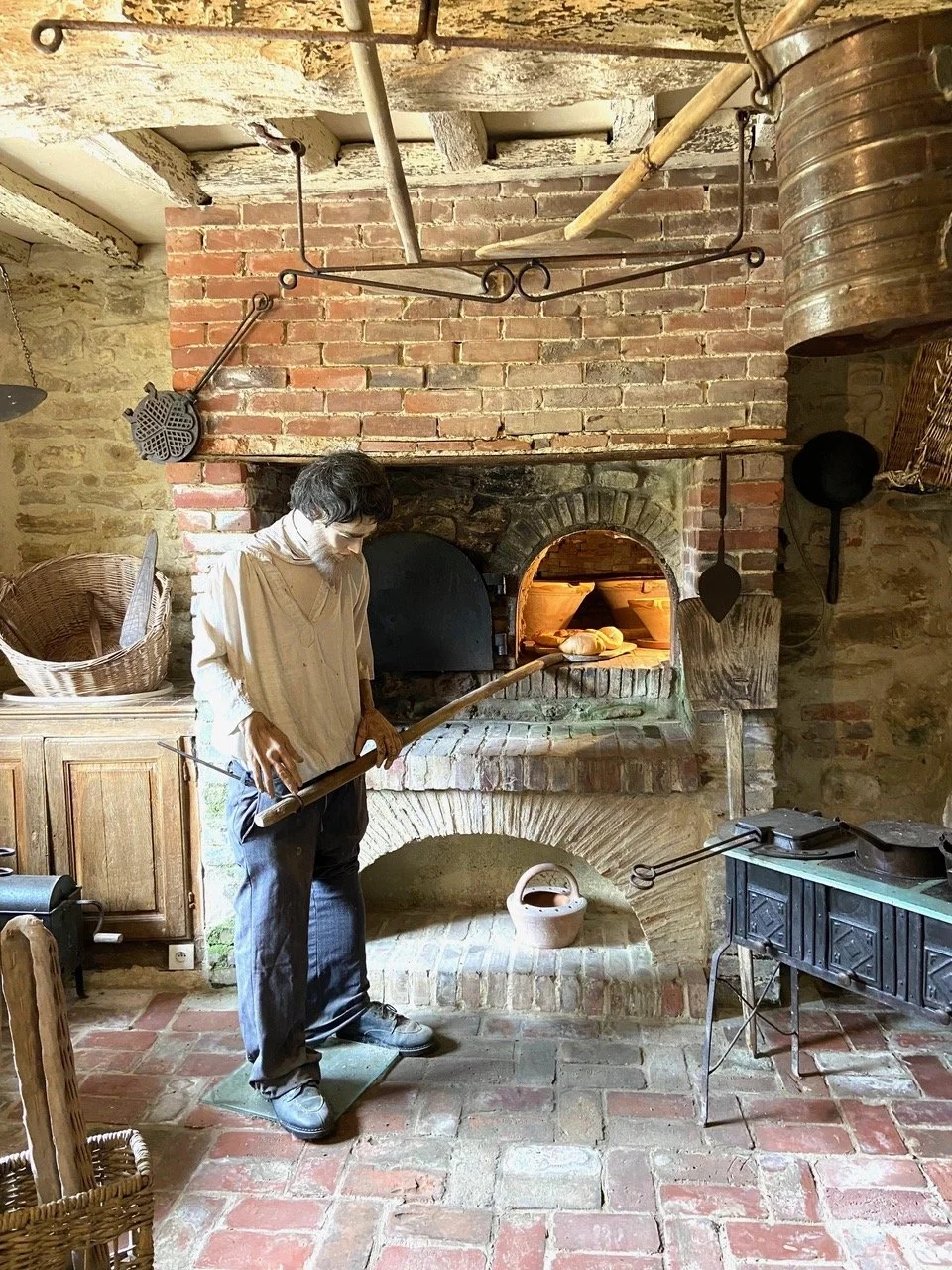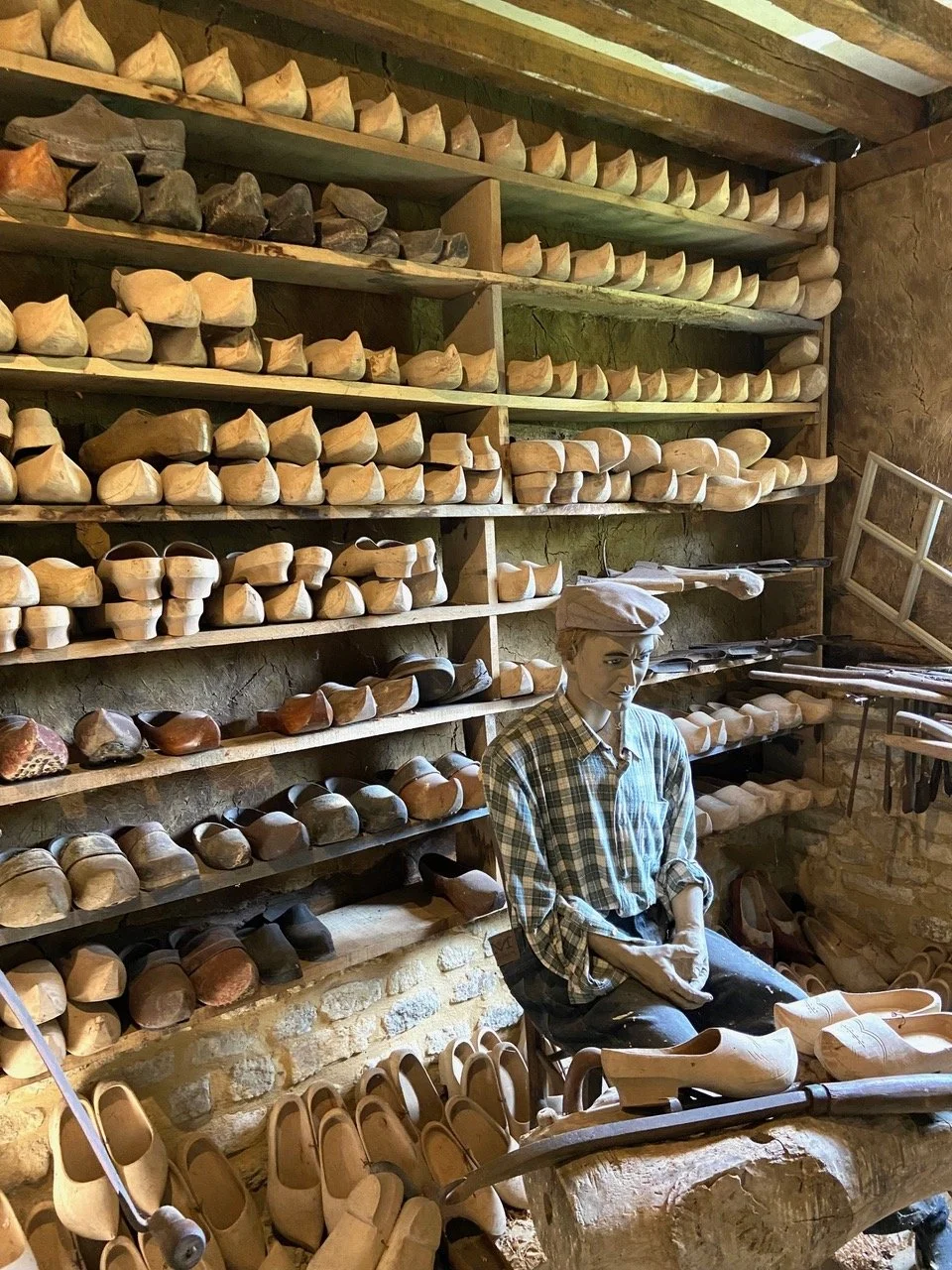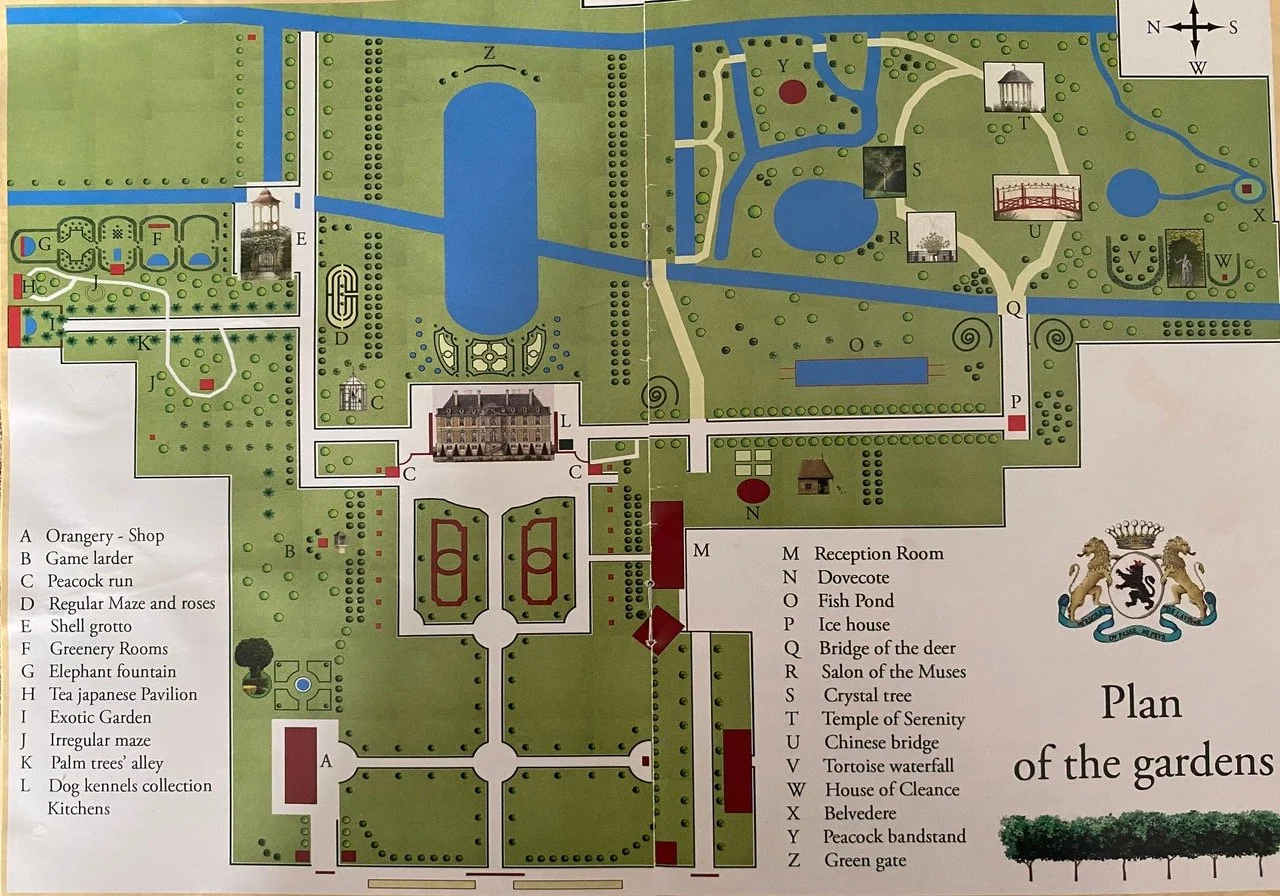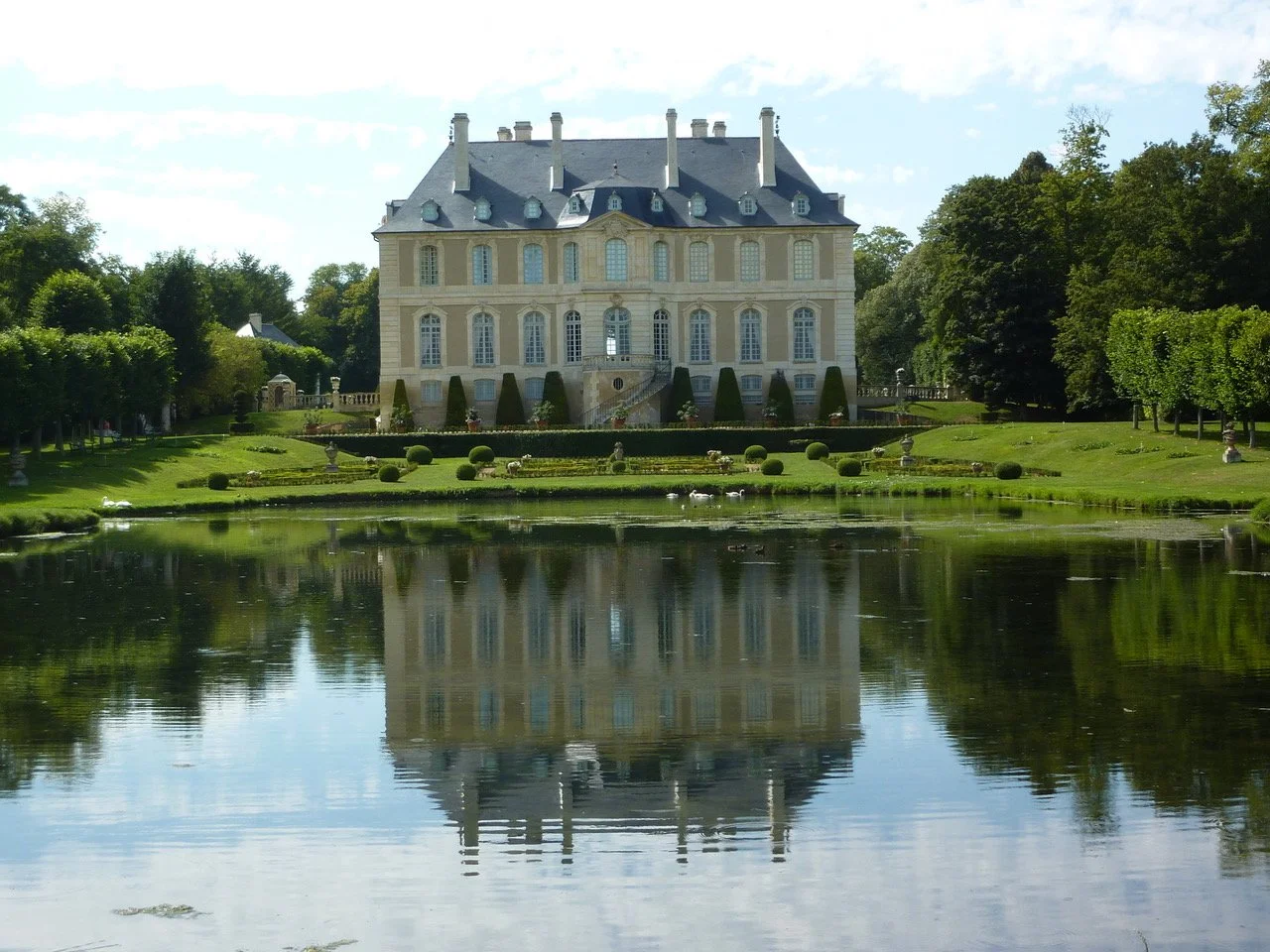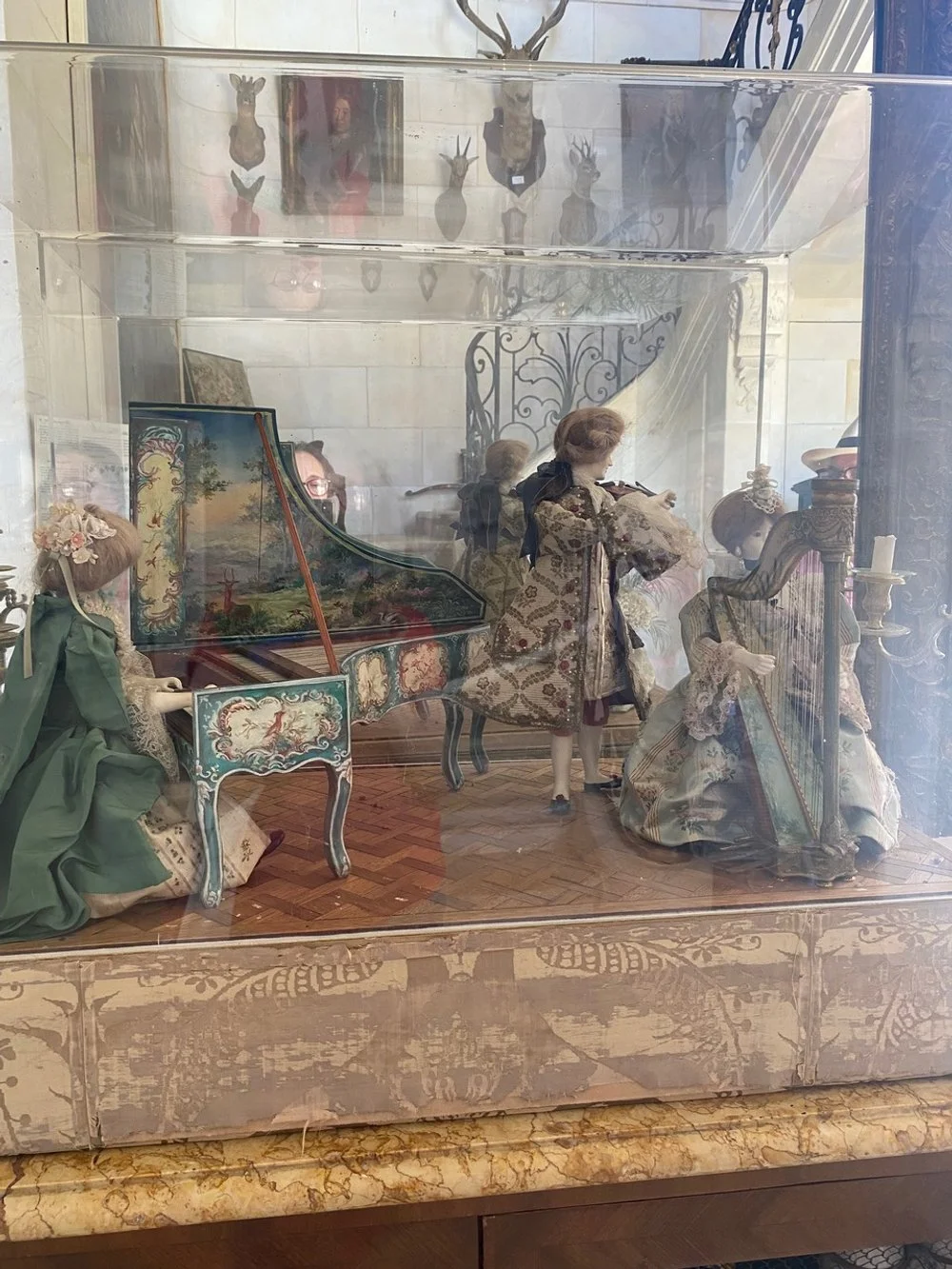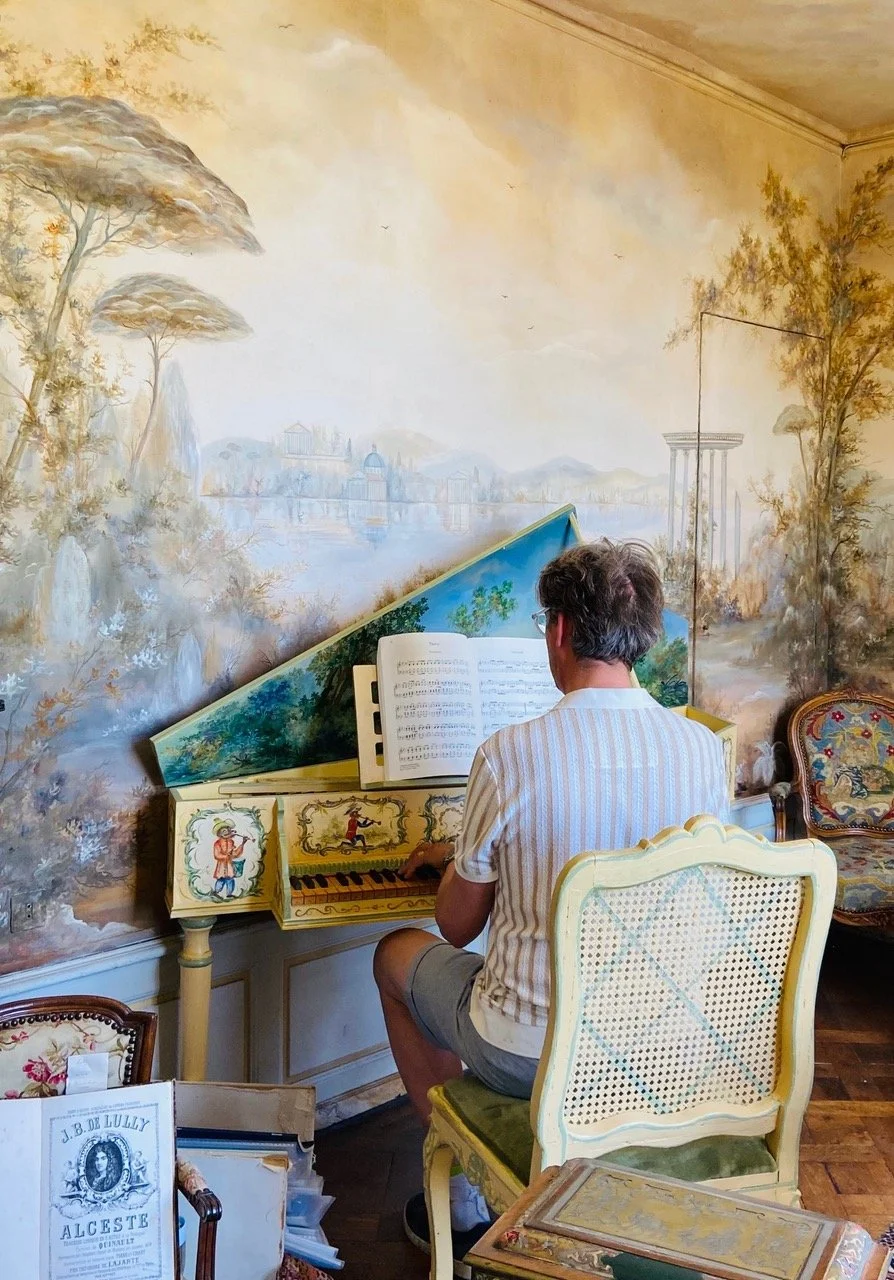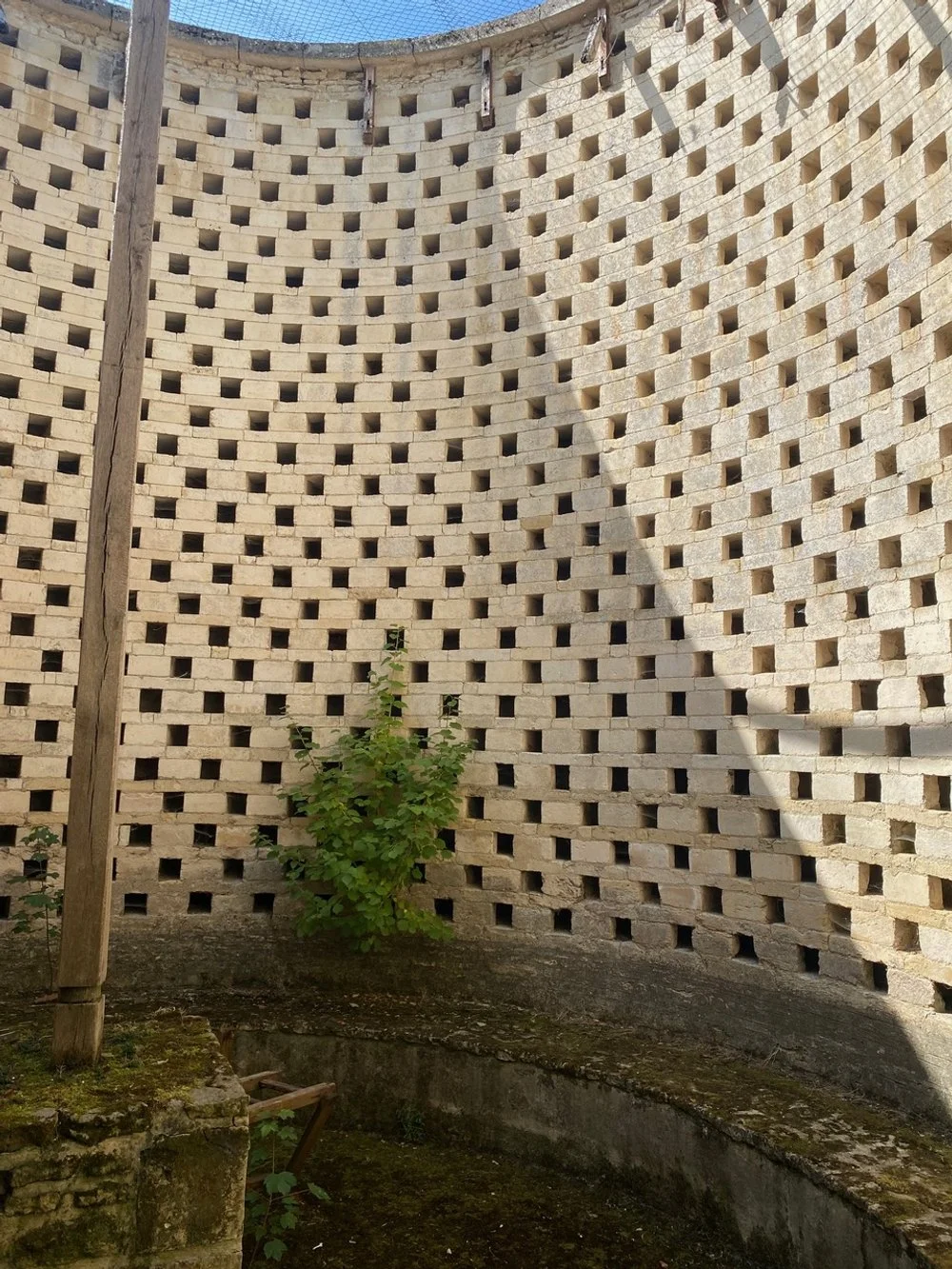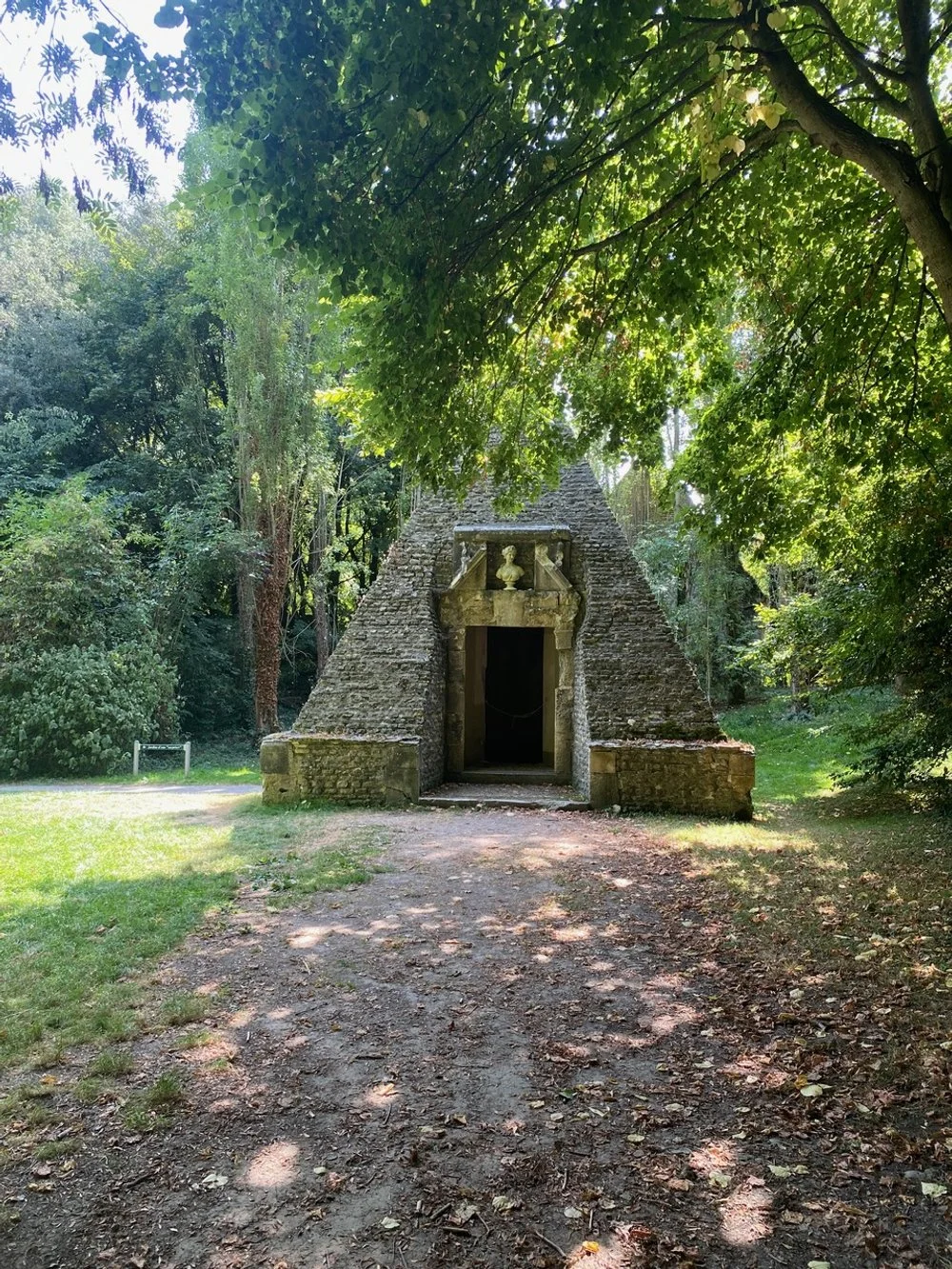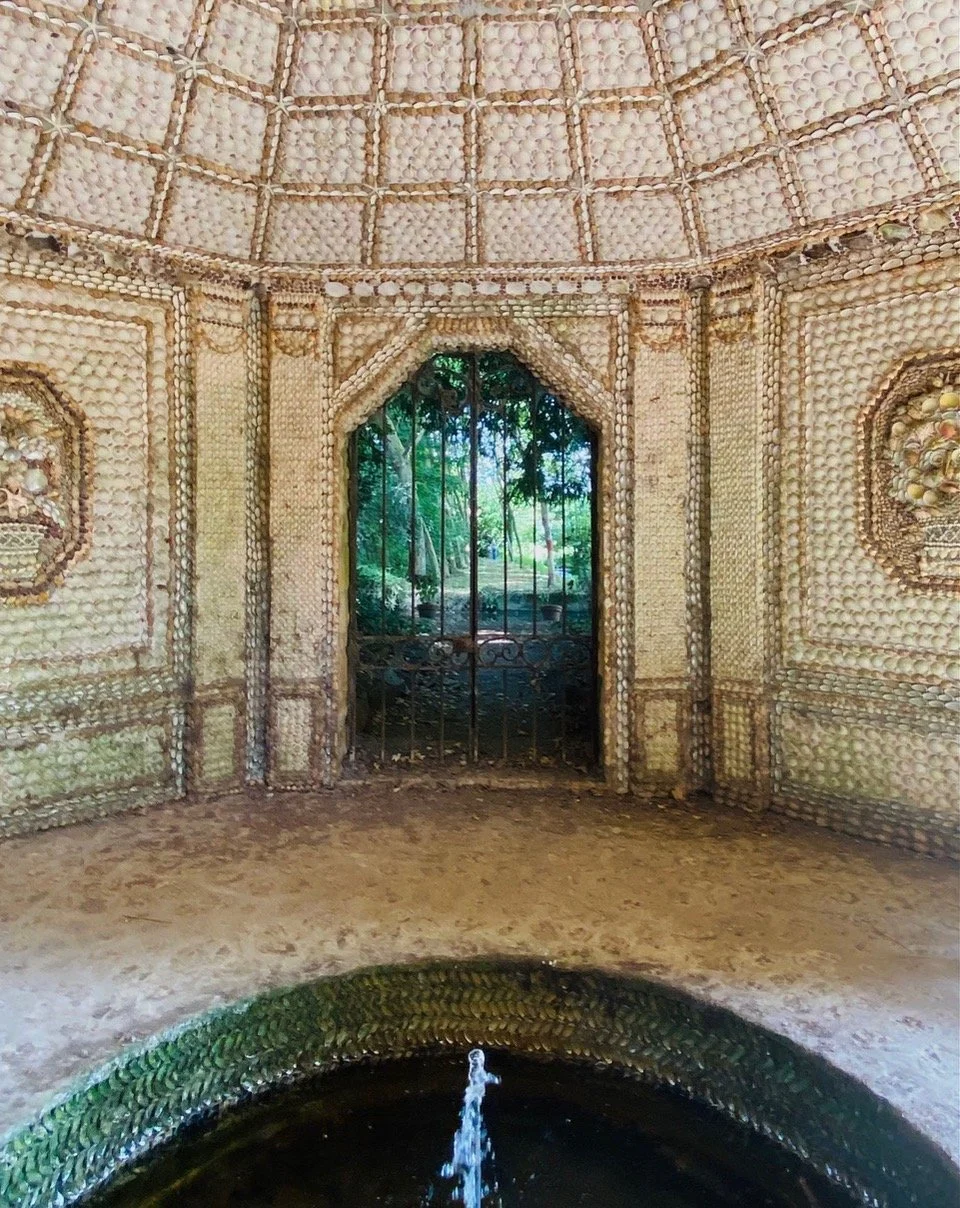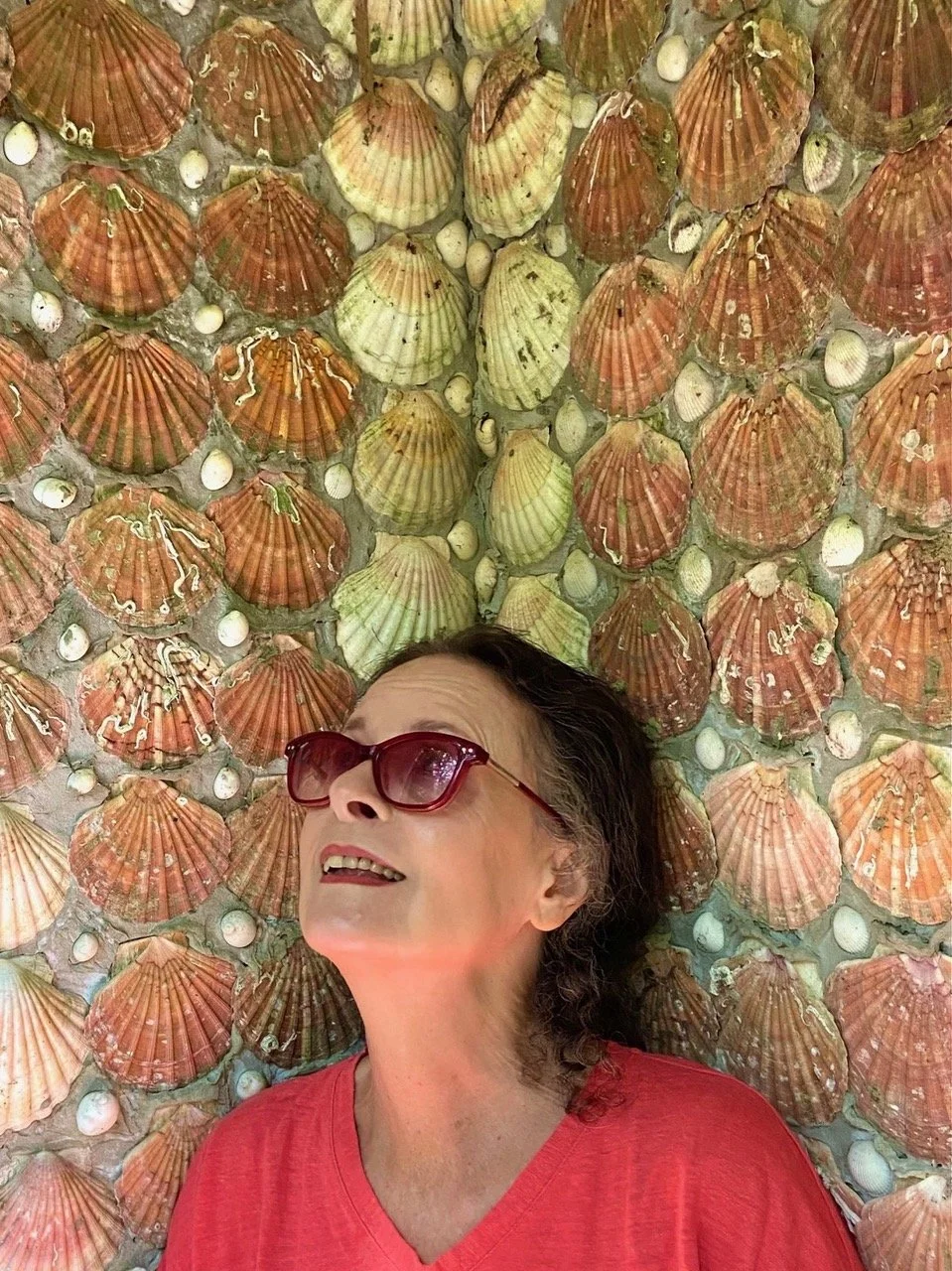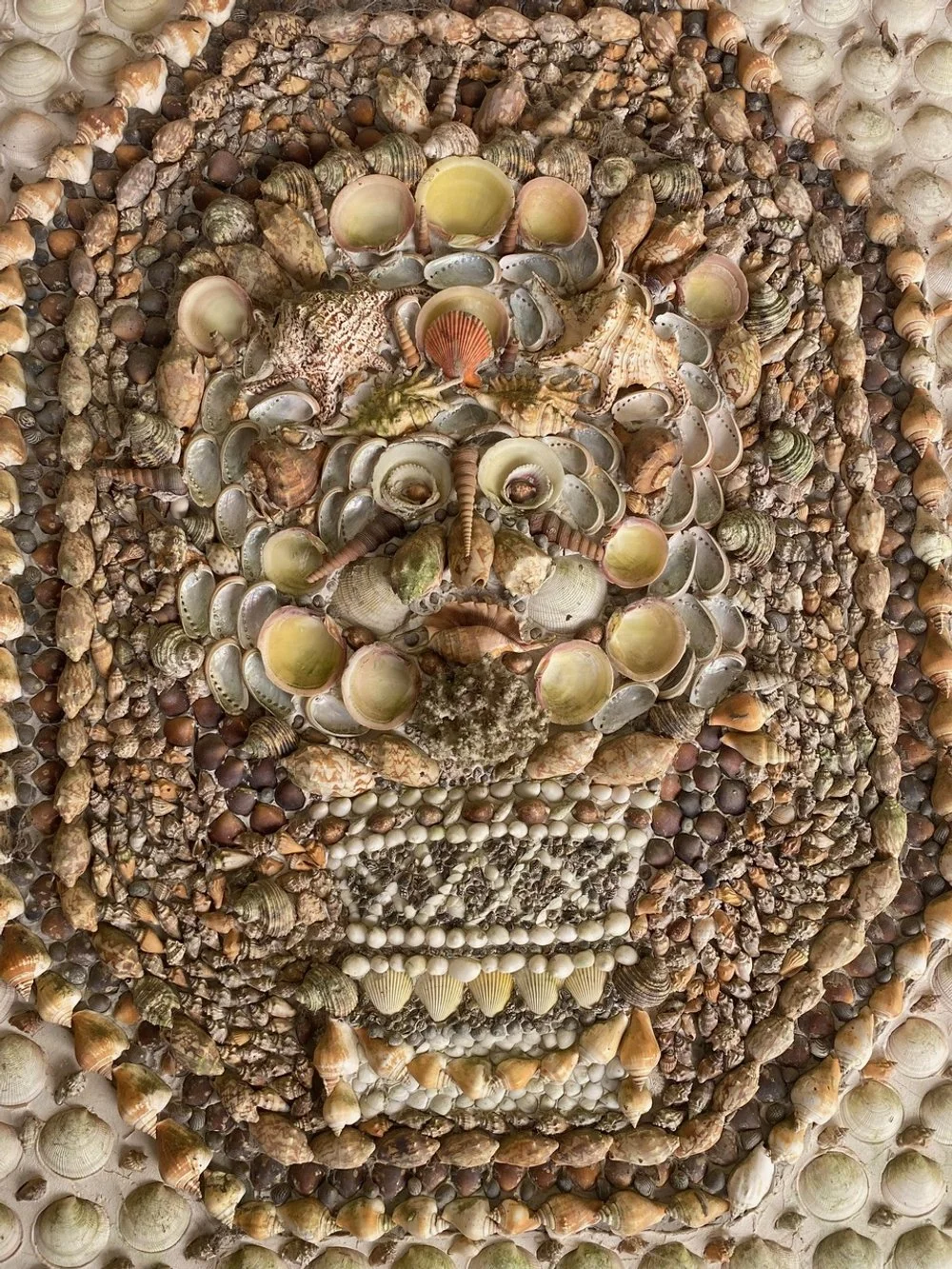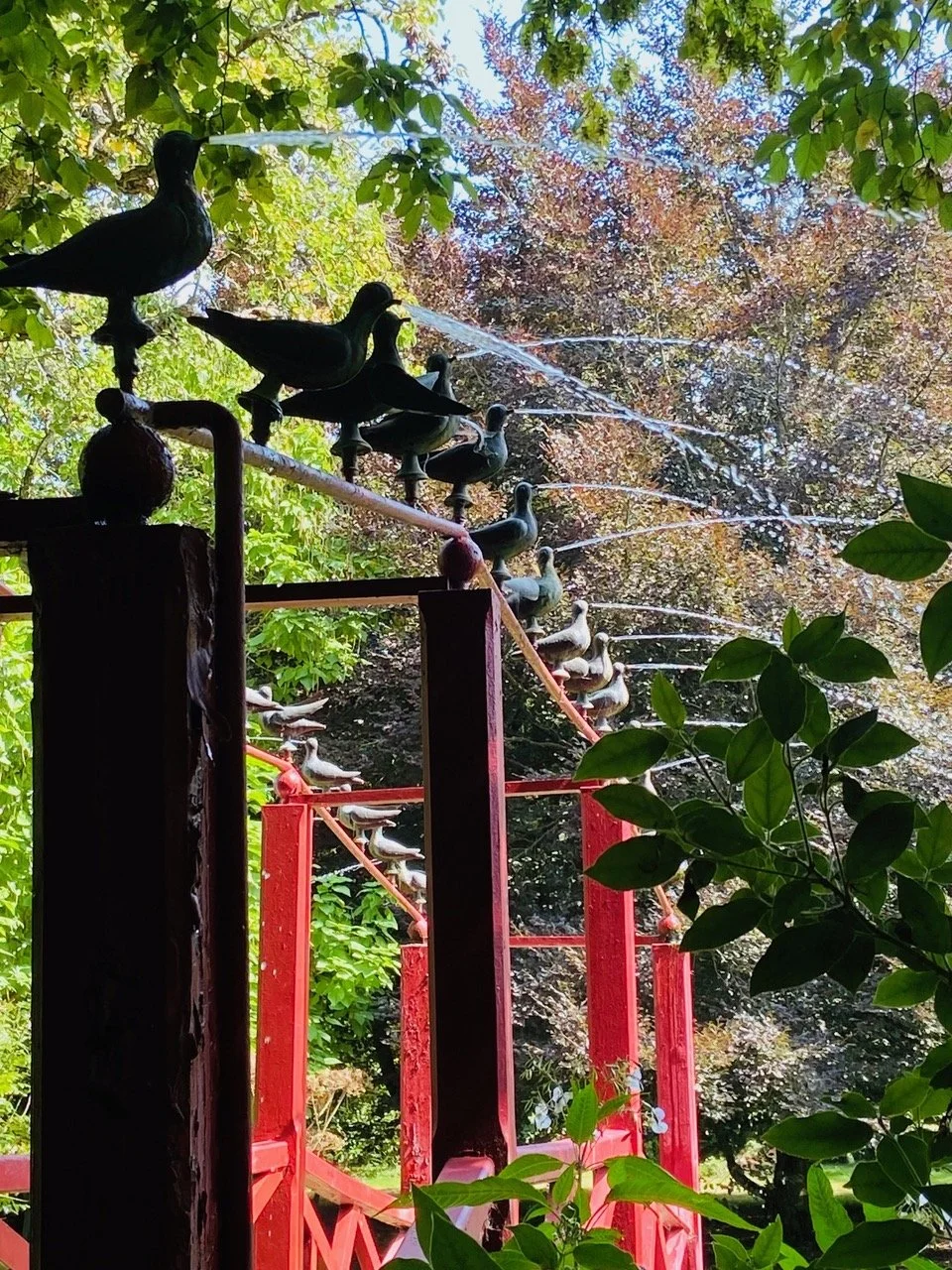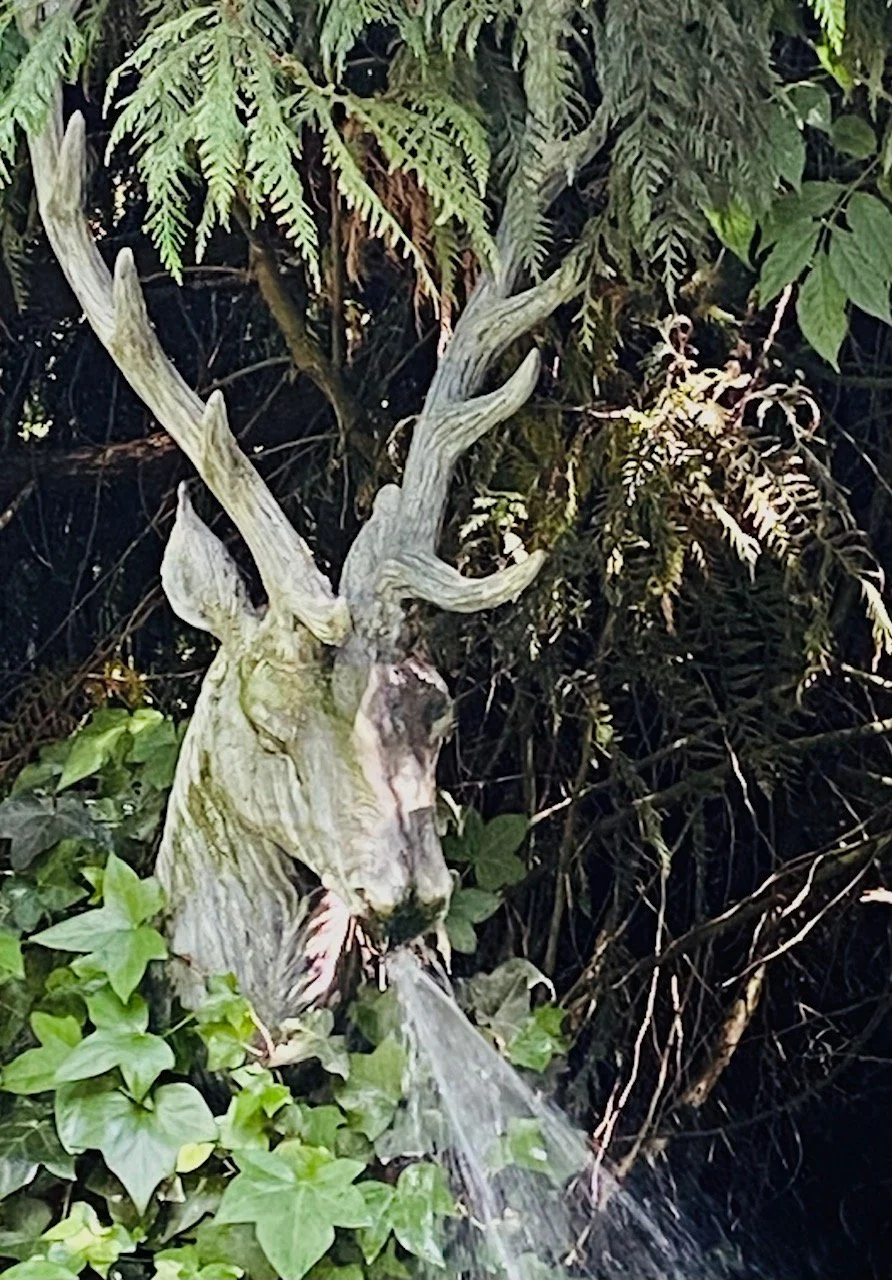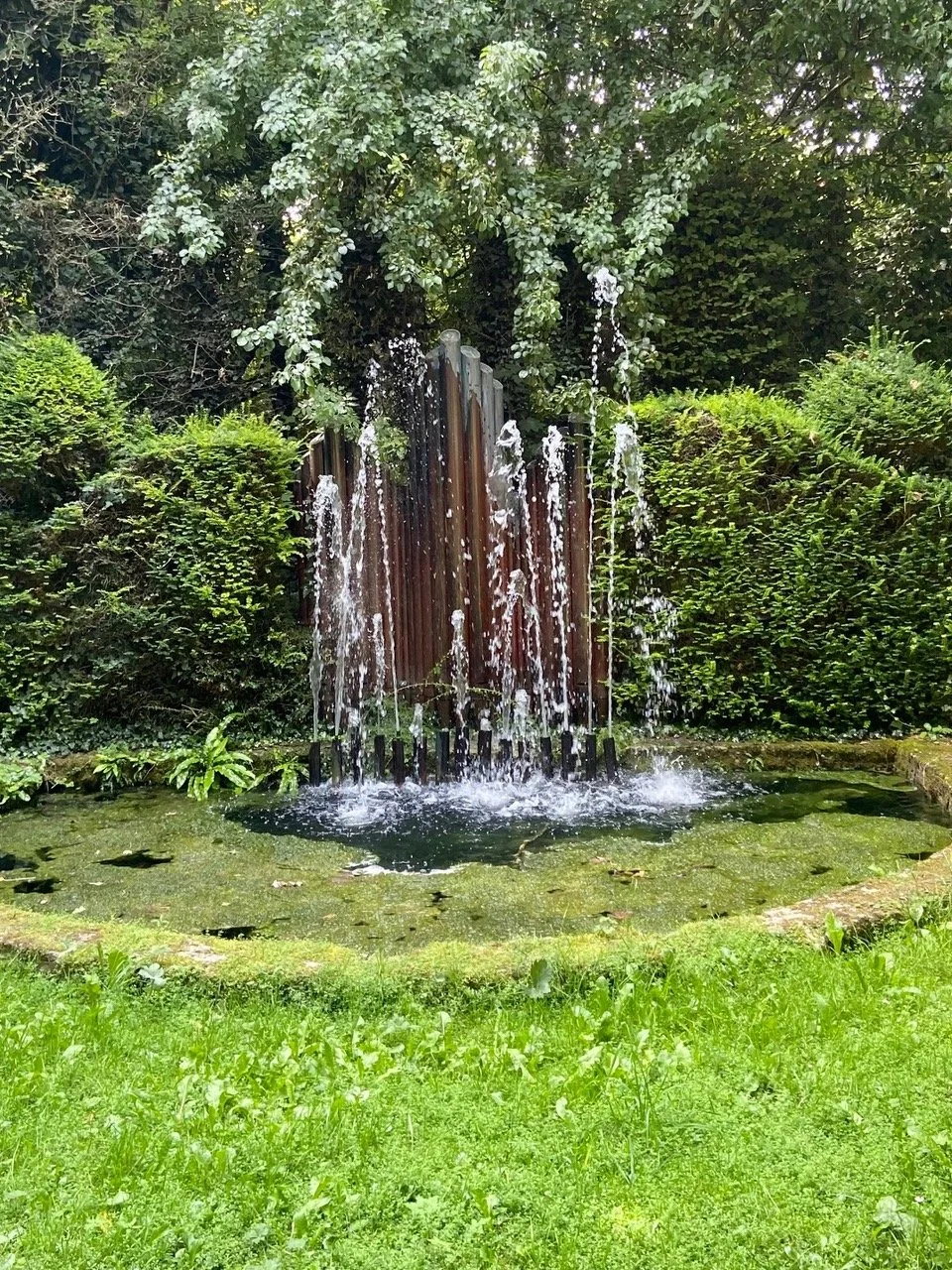Gardens are my favorite places
Me at Boutemont
Bienvenue and welcome back to Musée Musings, your idiosyncratic guide to Paris and art. This week we’re in Normandy to talk about three gardens I found close to where I was staying, in Dives-sur-Mer, a short walk along La Manche from Proust’s Cabourg. While I was in Dives, I also saw several exhibitions. At the Franciscaines in Deauville, ‘Bleu profound, L’océan révélé,’ was a group of disparate images under an unexpected but interesting umbrella!! (Fig 1) At the Musée des Beaux Arts in Caen, ‘L’horizon sans fin, de la Renaissance à nos jours’ explores the importance of the horizon line in images from the Renaissance to the present. Which is exactly what Hockney upended in most of his paintings. The exhibition at MuMa in Le Havre was about those gorgeous ocean liners (paquebots) that took the rich and famous across the Atlantic Ocean between the wars. All of those museums have excellent permanent collections and wonderful temporary exhibitions. All of them are well worth a visit next time you are in Normandie.
Figure 1. Me at Franciscaines Museum becoming part of exhibition, 'Bleu profound, L’océan révélé’
There is one exhibition that I will tell you about, ‘Varian Fry - les chemins de l’exil’, which is at the Mémorial de Caen (until January 2026). Fry, a journalist, agreed to go to France in the early 1940s. With a little money and a big mission - to save as many Jews, intellectuals and others, who were threatened with deportation by the Nazis. He was ignored during his lifetime and forgotten afterwards, but has come out of the shadows recently. When I mentioned the exhibition to a friend, I learned that Netflix has a 7 part series, ‘Transatlantic,’ which tells Fry’s story and the stories of the people who helped him and the people they helped escape the Nazis and their French collaborators.
But today it’s gardens. No single thing compares to a garden. Because it is a mix of so many things. Like a painting, you can appreciate its color and texture, pattern and subject. Like a sculpture, you can move around it, admiring it from many angles. Like architecture, it defines your movement through space. Your other senses are in play, too - your sense of smell chief among them. Whether you bend down to smell a rose or simply breathe in the scent of lavender as it comes wafting by. There’s also sound, as the wind gently or dramatically rustles through the leaves of the trees. If you’re lucky, there’s also touch - like pinching a spiky rosemary sprig to release its scent. Of course if you find a garden with statues and follies and views, you’ve hit the jackpot! Gardens are the epitome of nature and culture, that is, nature enhanced by the hand of man.
The first garden I visited after Étretat whetted my appetite was the Chateau de Boutemont. The history of this chateau is as tortured as the rest of France. Somewhere between the 10th and 12th centuries, the lords of Boutemont built a feudal mound, a stronghold, at the base of the hill, about a hundred meters from the current chateau. A plaque indicates where the mound was and what it looked like. From the chateau you can walk along a path to the ancient Roman road that linked the major town of Noviomagus Lexoviorum (Lisieux in Roman times) to the harbor of Touques, near Deauville.
The Boutemont family stayed until the Hundred Years' War. After a few other noble families came and went, they returned at the end of the 17th century, during the reign of Louis XIV. And transformed what had been a defensive fortress into comfortable lodgings. The last lord of Boutemont who lived here held a government post under Louis XVI. When the French Revolution got underway, he had the sense to pack up and emigrate to England. The château was seized and sold as national property. And eventually abandoned. Chateaux are still easy to come by in France. The killer is restoring them.
It reminded me of the story a woman who attended one of my watercolor workshops in the Dordogne told me. She was a descendant of the family who had made a fortune making sewing machines. She said that when her grandmother, a wealthy young American heiress married to an impoverished French nobleman, inherited her father’s fortune, there was a stipulation in his will. Not one penny, I mean centime, was to be spent restoring her husband’s family chateau. It’s like throwing money down a well.
Luckily for this abandoned and derelict chateau, when Charles and Sarah Drouilly first saw it, they experienced a coup de foudre and bought it. That was in 1915. And luckily for them, Charles Drouilly was a wealthy Parisian merchant. His game was hats - he made them and sold them - at a time when everybody wore them, sometimes changing them a few times a day. In addition to restoring the chateau, the Drouillys transformed the garden. That is to say, they put the transformation of the garden into the capable hands of Achille Duchêne, the landscape architect to the stars. Who is the real hero of this story, if we’re talking about gardens and we are.
Duchêne was a trained engineer who achieved great success as a landscape architect during the Belle Epoque and again during the Années Folle (Roaring Twenties). The ‘Duchêne style’ combines the mastery of French landscape art with Duchêne’s personal interpretation of whatever original garden he found himself in. As the designated landscape architect for high society, Duchêne created or recreated gardens in Normandy, Paris (the gardens of Albert Kahn and Hôtel Matignon), England, (the Water Garden at Blenheim Palace), Germany and the Netherlands. His project for the fabulous Vaux-le-Vicomte, begun in 1911, is perhaps his best known.
Before I tell you about the gardens, I will mention that, like most other places in Normandy, there’s a German connection. Field Marshal von Rundstedt was headquartered here. A member of the Prussian nobility and the oldest general in the German army, he despised the Nazis. Von Rundstedt was responsible for preparing the German army for the landing of the Allied forces. Luckily for us, the British disinformation operation convinced von Rundstedt that the primary attack would occur in the Pas-de-Calais. After the Normandy Landing, von Rundstedt was relieved of his command. He was reinstated a month later. After a third dismissal, von Rundstedt went to a Bavarian sanatorium where he was taken prisoner by the American army. Too old and too sick to stand trial, he died at home in 1953, he was 77.
After the war, the chateau changed hands a few more times. There was a single owner from 1976 until 2020, willing to jump on the treadmill and continue the never-ending task of restoration and reinvention. They spruced up the old gardens (pond and fountain and topiary garden) and created new ones (Italian garden and boxwood waves). Since 2020, the new new owners have restored three rooms of historical interest in the chateau and with three gardeners, they have created four new gardens, including a Zen garden and a ginkgo garden. And they added signage. The signage is excellent, it made finding my way from one garden to another a breeze! (Figures 2-12)
Figure 2. Château and Jardins de Boutemont
Figure 3. The Château of Boutemont from the pond, jet of water off
Figure 4.The Château from the pond, the jet of water on
Figure 5. Château's pigeonnier
Figure 6. These fabulous flowers, like flames, were in bloom everywhere
Figure 7. Waves of greenery were everywhere
Figure 8. The box hedges at the corner of the chateau
Figure 9. Zen Garden, simple and serene
Figure 10. The Elf’s House
Figure 11. The Elf’s House - interior
Figure 12. A drawing of the Mound where the Mound originally was
Actually the signage at Boutemont is so good that it made the signage at the other two gardens I visited, especially the first one, a bit of a struggle. The garden of the Pays d'Auge in the village of Cambremer, inland from Deauville, occupies 3 hectares. Apparently the woman of the house is the gardener. I saw her working. A woman alone cutting and hauling huge masses of cut branches. The man of the house mans the ticket booth. I’m not sure gardens are his thing. And maybe not casual visitors either. This garden started out as a meadow surrounding an old farmhouse. The owners transformed the land into a series of gardens, each with its own theme. The Jardin du Soleil, for example, has plants with golden leaves and flowers with bold splashes of red and orange. The Jardin de la Lune is filled with silver leaves and a pool of water that reflects the light. There’s also a water garden, a fragrance garden, a box garden and a purple garden.
Throughout the garden there are half-timber buildings which the garden’s owners found and rescued from various locations and in various stages of decay. They moved them to their garden and restored them. Some, which form part of the garden trail, have been fitted out to show various crafts and trades - a baker, a forger, a shoemaker. Others, on the edges of the garden, are gites (little houses) available to rent. I got the sense that the owners are more interested in weddings than in casual visitors. The vibe was as much nature and commerce as nature and culture. I’m guessing that there’s a tax incentive attached to welcoming visitors. (Figs 13-20)
Figure 13. Map of Jardins des Pays d’Auge
Figure 14. One of the lanes at Jardin des Pays d’Auge
Figure 15. Me at Jardins des Pays d’Auge
Figure 16. Jardin des Pays d’Auge
Figure 17. Jardin des Pays d’Auge
Figure 18. Jardin des Pays d’Auge building
Figure 19. Inside one of the buildings a Boulanger makes his bread
Figure 20. A cobbler in another of the buildings
The third garden I visited was the Château de Vendeuvre, which was built in 1741. As the description of the chateau reminds us, it was the 18th century when parks and pleasure residences replaced austere medieval castles. Less than 50 years after this chateau was built, the French Revolution began. For whatever reason, the owners didn’t fear for their lives so they didn’t leave France. And their chateau was spared.
Damaged during WWII, the current Count of Vendeuvre, a direct descendant of the first Vendeuvre, decided to restore it. The roof was the first item on the agenda. As a neighbor told us as he and I and my husband contemplated our little pigeonnier, without a roof, walls begin to crumble and eventually an entire structure melts away. Replacing traditional roofs is expensive. Ours cost the same as the pigeonnier did. When I see an old property for sale, the first thing I look at is the roof. If there’s too much roof, it’s too much money. Happily, this family had enough money to restore the roof.
This chateau was run professionally. You could buy a ticket to see everything or a ticket to see some of the things. I chose the chateau and gardens and gave the Dog Kennels and Miniature Furniture Museum, which is located in the former orangery, a pass. Although it was tempting when I read that it was “an exceptional collection containing over 700 pieces of furniture and thousands of small objects that demonstrate the nobility's passion for the decorative arts in the 16th century.” Maybe next time…..
On the ground floor of this chateau, which is inhabited on the upper floors by the family, everything that the owners are happy for you to see is stuffed into a few stuffed rooms. According to its Wikipedia entry (surely written by a member of the Vendeuvre family), each room presents a theme of daily life: the art of entertaining in the dining room, the art of dressing in the master bedroom, the art of writing in the study, the art of portraiture in a small living room, the pleasures of games in the guest room. Automatons and miniatures are scattered about and relate directly to the theme of each room. The decor and period furniture are intended to transport the visitor back to the daily life of an 18th century noble family. In an alcove off one room, someone was playing a pianoforte, maybe the current Count de Vandeuvre. He didn’t introduce himself, I didn’t introduce myself either. When I commended him on his playing, he identified the pieces and told me that he was practicing for a concert series that was to be held at the chateau in September.
The gardens are a mix of French, English and Italian Renaissance styles and sensibilities. A French garden, bordered by lime trees, has topiary at the front and a suspended water mirror at the back. From the terrace, the view goes beyond the meadows of the Dives valley to the hills of the Pays d’Auge.
There’s a Utility Garden, the centerpiece of which is a pigeonnier built in 1811. It has 1,400 pigeon holes. That’s not a pigeonnier, it’s a pigeon hotel or maybe apartment building. It has an impluvium roof so that the rain that falls into the central basin gives the pigeons an indoor(ish) or at least private place to bathe. Nearby is is a pyramid shaped building. It’s the icehouse. Ice was collected on very cold days and then kept in the interior well. A double door, facing north, kept it cool.
There’s a Chinese Bridge, a Crystal Tree, a Fountain of the Muses, a Temple of Serenity and a Turtle Waterfall, all of which have particular meanings which are not immediately apparent when you visit the chateau’s gardens but which you can learn about when you read about the chateau. I will tell you about two.
The Water Nymph’s Grotto. Neptune, the Greek god of the seas, was infatuated by the beautiful nymph Cléance. One day, seeing her asleep, he jumped at the chance to jump on her and have his way with her. She fought off his advances and defended herself so well that Neptune “had to beat a hasty retreat”. Furious, he turned her into stone because, he said, ”The coldness of stone suits you," Despite the sea nymph Thetis’ entreaties to the gods on Olympus, Neptune refused to change Cléance back into a nymph. But there was a compromise, “Cléance would remain a statue but behind her stone chest would continue to beat her generous heart.”
The Shell Cave. Under a pavilion with an exotic-inspired copper roof, is a "cool room" where one can rest on very hot days. “According to Greco-Roman mythology, a young nymph, pursued by the god Pan, took refuge in a cave, taking the form of a fountain of pure water…The 200,000 shells used in Vendeuvre create the supernatural atmosphere suitable for the nymphs' dwelling.”
At Vandeuvre, there are also two labyrinths, one is regular and easily mastered, the other requires the visitor to try their luck and sometimes retrace their steps.
The current Count of Vendeuvre is also a bit of a jokester. Inspired by Italian Renaissance gardens, he has added giochi d’acqua, or water jokes to his garden. Scattered throughout the garden, jets of water are unleashed on unsuspecting visitors who ‘trip the switch’ and either get drenched or get yelled at by their companions who get the drenching. Owners of Italian Renaissance gardens enjoyed the game and so does the current Count of Vendeuvre. And visitors to the garden should, too. Especially if you are there on a warm summer’s day! (Figures 21-32)
Figure 21. Plan of the Gardens of Vandeuvre
Figure 22. Château de Vandeuvre
Figure 23. Some of the many miniatures
Figure 24. Someone playing the pianoforte during our visit
Figure 25. A few of rooms in the pigeon hotel / apartment building
Figure 26. Pyramid Ice House
Figure 27. Shell building
Figure 28. My face in the shell building
Figure 29. One of the shell faces in the shell building
Figure 30. One of the water tricks
Figure 31. Another water trick!
Figure 32. Another water trick
Next week I’ll tell you about my adventures in Scotland. Gros bisous, Dr. B.
Thanks to everyone who sends Comments, they are much appreciated.
New Comment on Cleopatra: History / Legend // Myth/Icon
Another terrific article. And another reason to love Paris - where else would you find such a fascinating and multi-faceted (hurrah for Swarovski) exhibition. Peg
Loved this thoughtful piece on Cleopatra! Piqued my interest to learn more of her
true story. Thank you! GG
New Comments on Noodling around Normandy
Please take me next time you visit Normandie! Sharon, Haifa
Thank you, Beverly, for sharing your time in Normandy! This post is filled with an amazing amount of incredible sights! I have to admit that I especially enjoyed the combination of culture and gardens too. And I loved the segment on Etretat and the combination of natural beauty and artists' renditions of the place. And yes, the lending library looks charming and what a wonderful idea to place it right at the beach where people could find a book and a comfortable place to sit, read and enjoy the beautiful view every time they look up! Keep enjoying, Sydney, Portland, OR
Have you been to the Kreeger in D.C.? Some gems of Monet's E'tretat there! Elena
New comment on Brave Kusama:
Awesome article! Thank you! Carolyn

